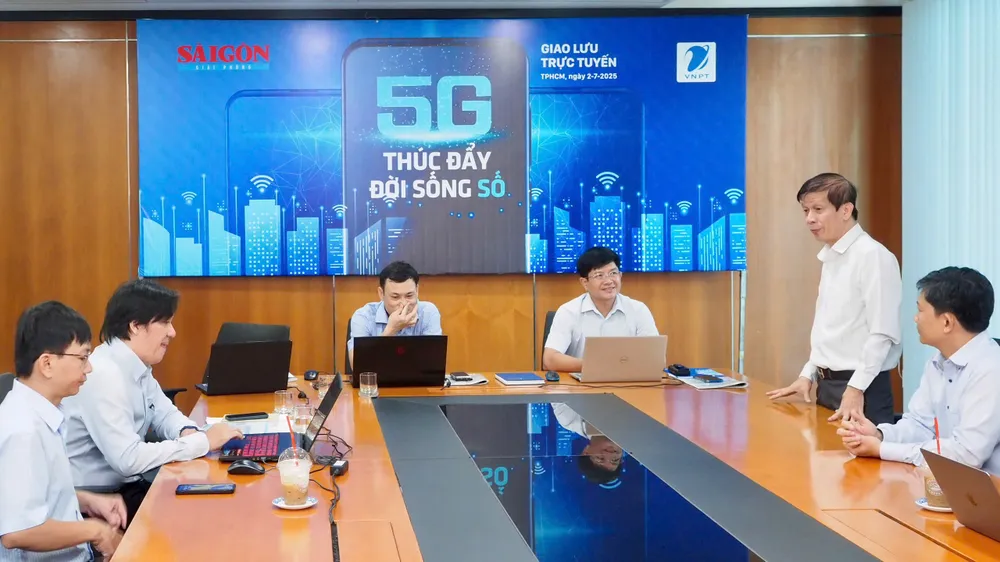
In Vietnam, 5G has been commercialized and is gradually asserting its important role in upgrading digital life by providing faster connection speeds, lower latency and the ability to connect more devices... creating conditions for many new applications and services. 5G helps improve entertainment experiences, support industries such as manufacturing, healthcare and education and promote digital transformation on a large scale. In particular, in the context of merging into the new Ho Chi Minh City, the development of 5G infrastructure becomes even more important.
In order to inform readers to better understand 5G technology, its application capabilities as well as the greater values that 5G brings, Saigon Giai Phong Newspaper organizes an online exchange with the topic "5G promotes digital life" at 9:00 a.m. on July 2, 2025 on SGGP Electronic Newspaper with the participation of:


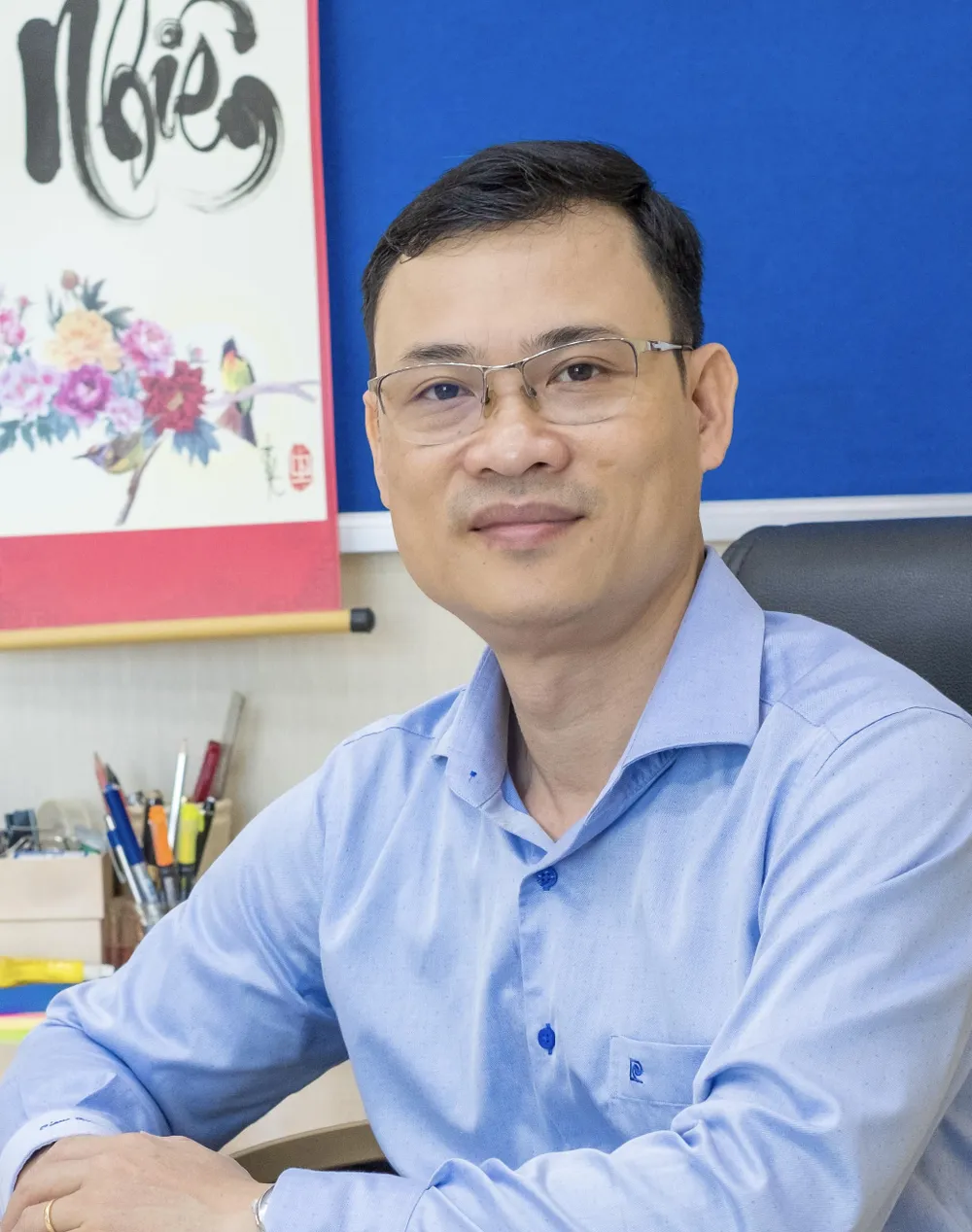
This is an opportunity for readers to learn more about the application of 5G in life and economic sectors, as well as ask questions and exchange directly with experts and representatives of agencies and units deploying digital infrastructure in Ho Chi Minh City.
Interested readers are invited to visit: www.sggp.org.vn to participate in asking questions for the program.
Guest

Mr. Tran Lam Thinh, Deputy Director of VNPT HCMC

Mr. Nguyen Trinh Dinh Hoa, Head of Post and Telecommunications Department, Department of Science and Technology of Ho Chi Minh City

Mr. Nguyen Duc Chung, Deputy Director of Ho Chi Minh City Digital Transformation Center
Interact with readers
Sir, currently VinaPhone has covered 5G in nearly 90% of Ho Chi Minh City, including the central and suburban areas. So, can you tell me specifically how much has been covered so far and which areas have not been covered?

Currently, VNPT covers many important locations and prioritizes investment efficiency and customer experience in Ho Chi Minh City.
There are about 1,000 new 5G stations in Ho Chi Minh City and 1.5 million 5G subscribers. It is expected that by the end of 2025, this number will be 3,000 stations with 3,000 subscribers.
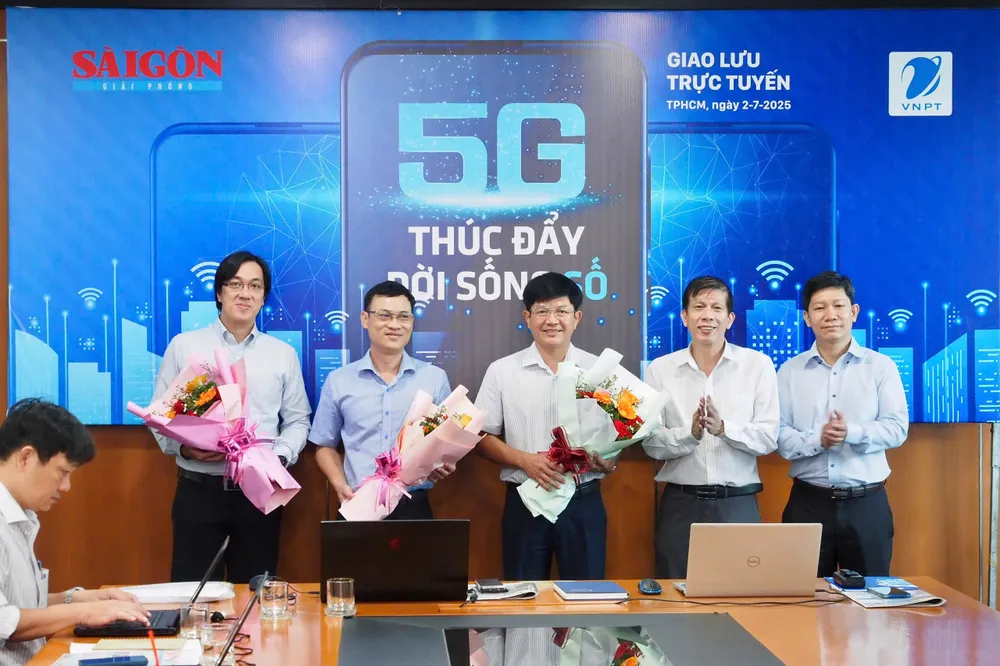
Sir/Madam, how many more 5G stations does VinaPhone plan to deploy to cover the entire area of 6,772 km² of the new Ho Chi Minh City, and what is the specific roadmap for each phase to ensure completion by 2025?

By the end of 2025, VNPT will install about 3,000 BTS stations for the new Ho Chi Minh City area (out of a total of 20,000 stations nationwide).
VNPT has clear criteria in planning, investing, exploiting and optimizing broadcasting stations.
Sir, which areas has VinaPhone prioritized to deploy 5G network first? And why did they choose those places as the first expansion points?

VNPT prioritizes densely populated areas; areas with many local People's Committee facilities; industrial parks; export processing zones; important areas such as ports, airports; Metro, highways...
Investment efficiency and customer experience are the criteria for choosing to develop the BTS network.
When deploying 5G in Ho Chi Minh City, did VNPT/VinaPhone encounter any problems - such as regulations, land funds, licensing procedures or technology - that slowed down the deployment?

VNPT complies with the laws on Posts and Telecommunications issued by the governing Ministry (formerly the Ministry of Information and Communications) and local regulations. However, after the issuance of Resolution 57 of the Ministry of Information and Communications; Resolution 193/2025/QH15 considering 5G as a pillar for technology development and digital transformation, network operators have much more advantages in developing infrastructure.
In particular, sharing infrastructure between carriers helps with quick deployment and saves a lot of costs.
What is the Department's orientation to take advantage of international cooperation, especially with organizations such as WEF and global C4IR, to improve technology and governance levels in 5G development?

In the context of the fourth industrial revolution taking place strongly, 5G technology is considered a key infrastructure platform to promote comprehensive digital transformation. To stay ahead of the trend and shorten the technology gap, strengthening international cooperation, especially with prestigious organizations such as the World Economic Forum (WEF) and the Global Network of Centers for the Fourth Industrial Revolution (C4IR), has become a priority direction of many localities - including Ho Chi Minh City.
Accelerating technological innovation on a global collaborative platform
In the context that 5G is not only a telecommunications technology but also a strategic infrastructure of the digital economy, it is extremely necessary to take advantage of the experience, resources and innovation ecosystem from international organizations. The Department of Information and Communications of Ho Chi Minh City clearly identifies: international cooperation is the lever to improve 5G technology and governance capacity in key sectors such as industry, logistics, smart cities and innovation.
One important direction is to strengthen connections with the global C4IR Network, coordinated by the WEF. This network includes innovation research and policy centers located in countries such as the United States, Japan, South Korea, India, the United Arab Emirates, etc.
C4IR provides a public-private collaboration platform where governments, businesses and research institutes can experiment with new technology governance models, including 5G networks and applications in Industry 4.0.
Orientation for international cooperation in 5G development
The city orients a number of specific international cooperation pillars to develop 5G technology and governance as follows:
1. Deeply involved in global initiatives and networks
The city will proactively participate in thematic initiatives such as “Smart Transportation”, “Advanced Manufacturing”, “Urban Digital Transformation” within the framework of WEF/C4IR. These are forums to share practices and connect the world’s leading experts in 5G deployment in factories, seaports and logistics centers.
2. Coordinate the development of testing mechanisms (sandboxes) and international standards
WEF is a place that supports many governments in building technology policy sandboxes - legal environments for testing innovation. The city aims to cooperate to build a legal framework for testing private 5G networks, data sharing standards, and security governance in the Internet of Things (IoT) environment.
3. Improve management capacity through training and knowledge transfer
International cooperation will help improve the capacity for planning and operating technology policies through online training courses or inviting international experts to advise. The city also plans to send officials to participate in coordination programs at C4IR centers to learn from advanced countries such as Germany, Japan, and Singapore.
4. Calling for high-quality FDI investment in 5G and core technology
Through the WEF network, the city can connect with global technology corporations such as Ericsson, Qualcomm, Cisco – active members of the WEF 5G forums. This is the basis for calling for investment in high-tech parks, software parks, or public-private partnership projects, contributing to building an innovation ecosystem on the 5G platform.
5. Applying the WEF technology governance model and index framework
Governance frameworks such as those developed by the WEF will be adapted, tested and localized to serve the purpose of evaluating the effectiveness of 5G deployment in digital transformation in urban areas, businesses and the public sector.
Expanding cooperation to lead in the region
Determined to become a regional hub for innovation and high-tech industry, Ho Chi Minh City is proactively expanding international cooperation not only with global organizations but also with major cities such as Seoul, Singapore, and Dubai – leading places in digital infrastructure development.
The development of 5G is no longer a technical goal, but a strategy for smart, sustainable, and globally competitive socio-economic development. Through international cooperation, especially with WEF and C4IR, the city has the opportunity to improve its technology governance, standardize policies according to international practices, and gradually realize the vision of national digital transformation.
Sir, up to now, VinaPhone has about 5 million subscribers using 5G phones, of which 3 million subscribers have activated 5G packages. May I ask if you know how many of these subscribers are in Ho Chi Minh City, and is the city leading? If there are no specific numbers, does VinaPhone have a plan to update or publish local data?

There are nearly 1 million Vinaphone 5G subscribers in Ho Chi Minh City.
This number is currently the highest in the country. If counting HCMC today, this number is more than 2 million Vinaphone 5G subscribers.
This data is collected and reported to the Department of Science and Technology of Ho Chi Minh City and the Department of Statistics of Ho Chi Minh City monthly, quarterly and annually.
Can you tell me if VinaPhone currently has any special 5G packages for customers in Ho Chi Minh City? For example, incentives on data, calling minutes or savings combos? Thank you!

VinaPhone is currently offering a special incentive policy for all individual customers and households nationwide. In addition to the superior experience of 5G internet speed, 5G WiFi, high-quality voice on 5G, VinaPhone 5G also offers the ability to exploit high-quality entertainment ecosystems (My TV 4K/8K), augmented reality/virtual reality applications in learning/entertainment, support for the development of high-quality e-commerce/livestream and secure applications in the digital environment. These packages all have data sharing features, free access to social networks and benefits of the television entertainment ecosystem including MyTV Mobile (with VTVcab, SPOTV, Galaxy), VieON, OnPlus...
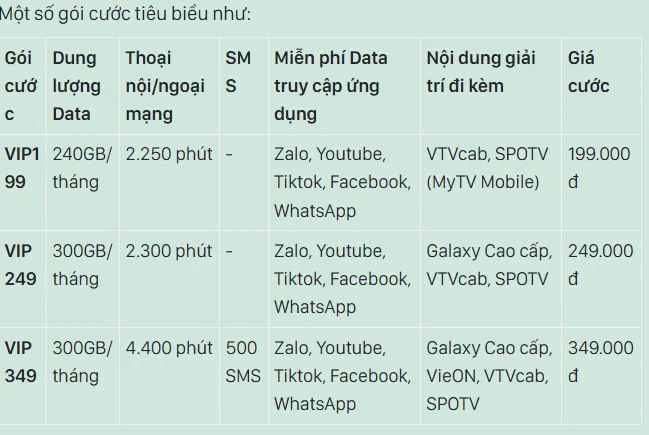
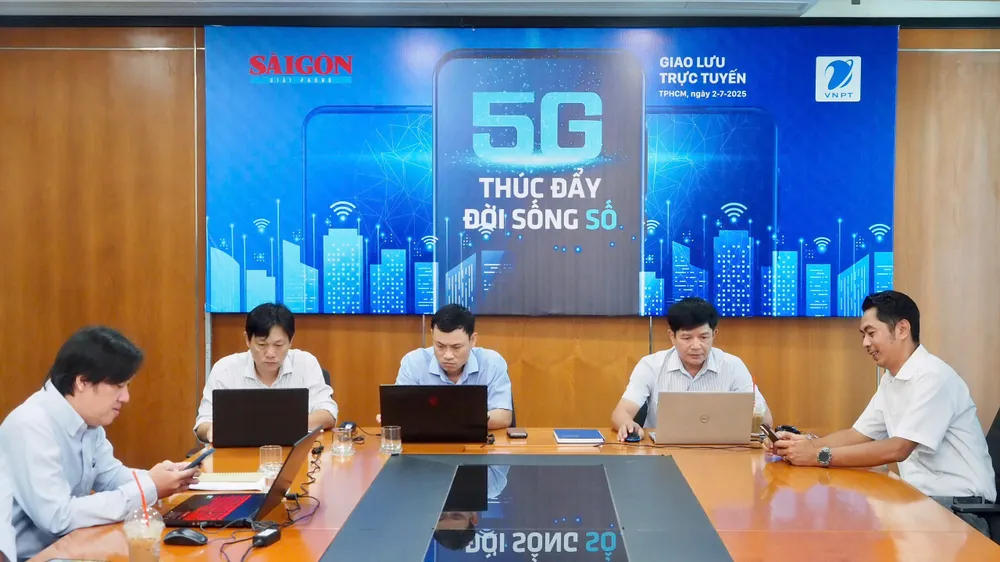
5G can help automate and operate intelligently in manufacturing, ports, and logistics. What specific solutions will the Department prioritize to take advantage of this potential?

In its comprehensive digital transformation strategy, Ho Chi Minh City identifies 5G technology as a key infrastructure for developing smart industry, improving production efficiency and optimizing logistics chains. As the economic - industrial - logistics center of the country, Ho Chi Minh City is implementing a series of specific solutions to take advantage of 5G to innovate the growth model, attract investment and lead the wave of Industry 4.0.
5G – A breakthrough driving force for industry and logistics
5G is not only a breakthrough in telecommunications but also a technological platform that opens up an era of automated production, real-time operations and comprehensive digital connections. In the context of Ho Chi Minh City's strong transformation to become a smart city, a regional innovation and logistics center, the deployment of 5G application solutions in factories, industrial parks and seaports is considered a strategic lever.
Priority solutions of Ho Chi Minh City
1. Developing specialized 5G network infrastructure in industrial and logistics zones
Ho Chi Minh City prioritizes deploying a private 5G network in key industrial parks such as the High-Tech Park, Tan Thuan Export Processing Zone, VSIP, Cat Lai, Hiep Phuoc Port... to ensure low latency, high speed and stable connection for automation systems.
2. Forming smart factory models
The city is collaborating with technology corporations, network operators and businesses to build a smart factory model, applying 5G to connect industrial robots, production lines, IoT sensors and operating systems (MES, SCADA).
Factories can:
- Monitor and control production processes in real time
- Automatic fault detection and predictive maintenance
- Optimize resource and energy usage
3. Modernizing seaports and logistics centers with 5G
As the largest import-export center in the country, Ho Chi Minh City promotes 5G application at seaports (Cat Lai, SP-ITC, Hiep Phuoc) and logistics centers to:
- Remote control of loading and unloading equipment, cranes and forklifts
- Real-time monitoring of goods and containers using AI sensors and cameras
- Automate storage, inventory management, import and export of goods via 5G-connected AGV/AMR robots
4. Developing a digital industrial ecosystem connected via 5G
The city aims to build a digital ecosystem for industrial parks including network infrastructure, mini data centers, smart management platforms, and network security systems. Thereby, supporting small and medium-sized enterprises to easily integrate into the smart manufacturing value chain.
5. Prioritize piloting and replicating the model
Ho Chi Minh City is planning:
- Pilot smart industrial park applying comprehensive 5G
- Calling for high-tech investment in the field of 5G - IoT - AI to serve production
- International cooperation (WEF, C4IR, global corporations) to test smart production and logistics models according to international standards
With a clear strategy and specific implementation roadmap, Ho Chi Minh City is affirming its pioneering role in applying 5G technology to serve smart industry and logistics. This is not only a step forward in infrastructure but also a reform of the growth model, helping the city:
- Increase labor productivity
- Reduce operating costs
- Attracting high-tech investment capital
In the coming time, Ho Chi Minh City will continue to accompany businesses in the digital transformation process, forming a new industry - a connected, automated and sustainable industry on the 5G platform.
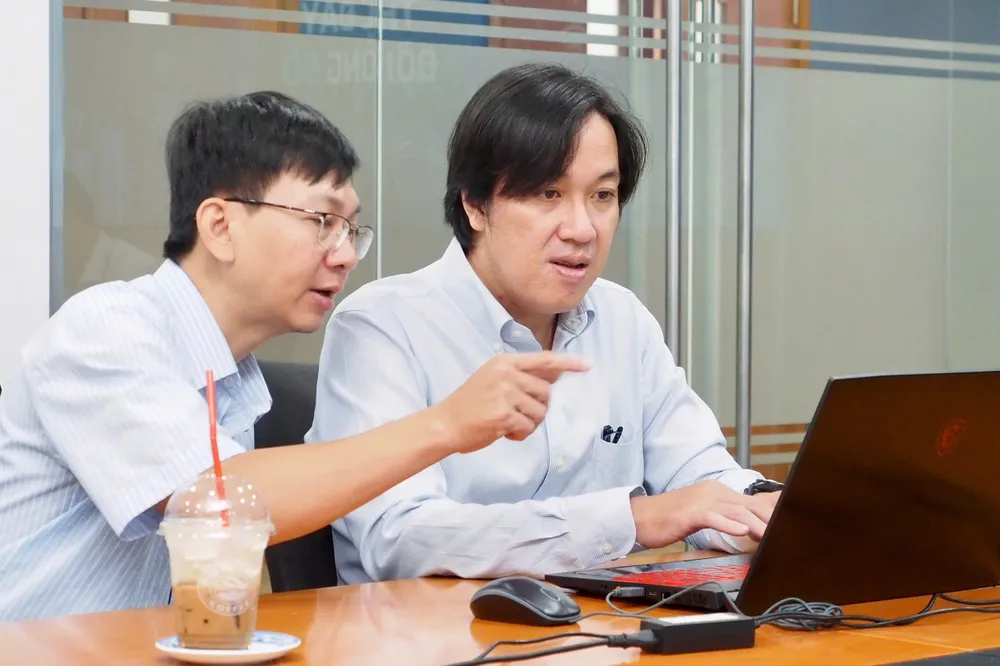
Sir, how does VNPT evaluate the current 5G wave quality in Ho Chi Minh City, especially in densely populated areas and industrial parks - where demand is high and continuous?

VNPT focuses on deploying 5G to enhance user experience and promote digital transformation, especially focusing on practical applications such as smart cities and industry 4.0. VNPT's strategy is not only to provide high-speed connections but also to develop 5G-based value-added services, aiming to become a leading digital service provider.

Specifically, VNPT is focusing on the following aspects:
Expanding 5G coverage:
VNPT is actively deploying 5G broadcasting stations to ensure widespread coverage, especially in urban areas and industrial parks.
5G Service Development:
VNPT not only provides 5G connection but also focuses on developing applications and value-added services on the 5G platform, including solutions for smart cities, industry 4.0, smart healthcare, smart education,...
Enhance user experience
VNPT aims to bring the best 5G experience to users, with high speed, low latency and high reliability.
Cooperation with partners:
VNPT cooperates with domestic and foreign partners to develop 5G solutions and services, and share knowledge and experience.
VNPT identifies 5G as an important factor in Vietnam's digital transformation process, and VNPT is committed to investing heavily in this technology to meet the increasing needs of customers and contribute to the country's socio-economic development.
The quality of 5G in Ho Chi Minh City where there are broadcasting stations (about 500 stations) is very good. However, it is not yet fully covered. VNPT regularly expands and controls customer experience.
People are looking forward to 5G with applications such as smart cities, remote medical examination and treatment, and smart transportation. Does VNPT have any such projects in Ho Chi Minh City? How far is the implementation?

Promoting the deployment of new applications based on 5G, especially solutions for developing IoT and private 5G ecosystems, are all included in the roadmap for exploiting digital infrastructure, specifically VNPT's 5G infrastructure.
VNPT is still actively coordinating with the People's Committees of provinces/cities and enterprises nationwide to apply solutions to directly serve people, improve the efficiency of state and business management activities, and meet the key tasks set forth by the Politburo in Resolution 57.
Example solutions: National Public Service Portal; VNEdu for education; HIS for healthcare; Digital signature and EKYC for banks and businesses; Igate and IOffice for 2-level local governments and businesses are typical solutions and ecosystems of VNPT on fiber optic and 5G platforms.
Sir, after the merger, there is still a gap in telecommunications infrastructure between the old Ho Chi Minh City, Binh Duong and Ba Ria – Vung Tau. So does VNPT have any specific strategy or plan to resolve this gap, to ensure a synchronous telecommunications infrastructure throughout the new Ho Chi Minh City?

After the merger, the Ho Chi Minh City area includes the entire old Ho Chi Minh City, Binh Duong and Ba Ria - Vung Tau. In terms of telecommunications infrastructure - including both terrestrial mobile network infrastructure and fixed broadband infrastructure - there is actually a certain difference between the regions. However, the difference is not large, because in recent years, all three localities are key socio-economic development areas of the country, always receiving attention from VNPT for investment and infrastructure development in accordance with the needs of management and operation, serving businesses and people.
From now until the end of 2025, VNPT will focus on comprehensively reviewing and optimizing the network structure throughout Ho Chi Minh City, ensuring data connectivity, synchronizing infrastructure architecture, aiming to build a unified - modern - effective network system, well meeting the digital transformation requirements of the government and the service needs of the people.
Ho Chi Minh City is now expanding, many suburban areas, rural areas, mangrove forests, new industrial zones also need good connectivity. So does the Department have any plans to ensure 5G infrastructure in these places?

After the merger, the new Ho Chi Minh City has officially operated since July 1, 2025, so the Department of Science and Technology organized a comprehensive review of the 5G network infrastructure in this area as soon as possible to fully assess the current situation and propose appropriate solutions to promote the development of 5G infrastructure to ensure ahead of schedule completion of the goal of 5G coverage for the entire new Ho Chi Minh City.
It is expected that in the third quarter of 2025, the Department of Science and Technology will submit to the Ho Chi Minh City People's Committee for approval the 5G infrastructure development plan for the 2025-2027 period, aiming to cover more than 90% of Ho Chi Minh City with 5G, including 100% of high-tech zones, industrial zones, export processing zones, administrative centers and densely populated areas.
Currently, telecommunications businesses are facing some difficulties and obstacles in the process of developing 5G mobile information stations in rural areas and mangrove areas, specifically the installation of BTS stations on agricultural land, forest land, etc. and in the use of land combining agricultural multi-purpose with the construction of telecommunications works.
However, this content has been guided in the Telecommunications Law, the Land Law and Decree No. 102/2024/ND-CP dated July 30, 2024 detailing the implementation of a number of articles of the Land Law. In the coming time, the Department of Science and Technology will coordinate with the Department of Agriculture and Environment, the Department of Construction, the People's Committees at the commune level and related units to promptly guide and implement this content.
Sir, does the Center have any plans to utilize 5G technology in developing AI, IoT and big data applications, especially in areas such as smart transportation, digital healthcare and digital education?

In the coming time, to effectively and successfully deploy AI, IoT and big data applications, especially in areas such as smart transportation, digital healthcare and digital education, it is impossible not to apply on the 5G platform.
Therefore, this is a necessary requirement that the center sets for product suppliers right from the design stage. For deployed products, the center will coordinate with the leading agencies to conduct research and propose solutions to upgrade and improve products to make the most of 5G technology.
Sir, how many more 5G stations does VinaPhone plan to add to cover the entire 6,772 km² area of the new Ho Chi Minh City? And where will these stations be deployed to ensure coverage of the entire area?

By the end of 2025, VNPT will install about 3,000 more 5G BTS stations to cover the new Ho Chi Minh City, with about 20,000 stations nationwide to receive support from the government according to Resolution 193/2025/QH15 and Decree 88/2025/ND-CP.
These stations have criteria for deployment to achieve the best user experience and investment efficiency. For example: Densely populated areas; Industrial parks - Export processing zones; Airports; highways; port clusters...
After merging administrative units, there may still be differences in technical standards or licensing procedures between the three old localities. So how will VNPT handle and unify this so that the 5G deployment is not interrupted, sir?

The difference in infrastructure including both terrestrial mobile telecommunications infrastructure and fixed broadband telecommunications infrastructure between the old localities is actually a difference but not significant, because in recent years, these localities have been key areas for economic and social development of the whole country, so VNPT has always paid attention to investment and construction, infrastructure to meet the needs of serving the direction and economic and social development of the localities and people.
In the period from now until the end of 2025, VNPT will focus on reviewing the network structure of these localities, to connect data and unify the complete network structure, better serving the government and people after the merger.
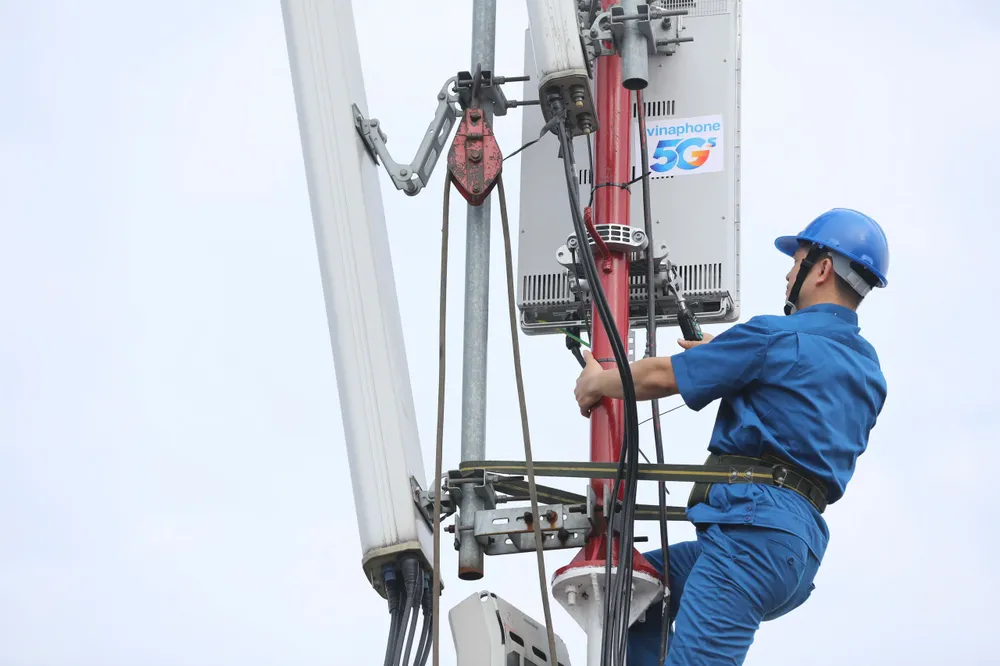
Sir, with the formation of new megacities, how will the 5G network resource and frequency allocation mechanism be adjusted to suit the scale, population density and increased usage demand?

Regarding the current allocation of 5G network frequencies and resources, it was not only when VNPT entered the province that the issue was raised and research was conducted on how to apply it. Previously, in the process of developing the radio network from 2G, 3G, 4G in the past and 5G today, VNPT had sets of standards and principles to help effectively exploit frequency and network resources. Accordingly, depending on population characteristics and traffic needs, when designing annual network development plans, VNPT considers adjusting the allocation of service resources according to a number of main criteria: Number of users, connection distance, and user service needs.
Sir, what technical solutions is VinaPhone currently applying to ensure seamless 5G connection when deployed through complex terrain areas such as rivers, mangrove forests or divided areas?

Through reviewing the 5G planning in Ho Chi Minh City, areas that are cut off from waves in addition to rivers and mangrove forests include: Highway construction sites, sea reclamation urban areas, large urban areas with an area of hundreds of hectares...
To ensure 5G coverage, VNPT will deploy a number of solutions such as additional construction of new broadcasting stations, field stations, and mobile vehicles to promptly meet 5G connection needs. Adding additional frequency bands of the Low Band band group for sparsely populated areas and Mid Band for densely populated areas to ensure quality coverage and bandwidth provided to users.
To limit interference, during the process of developing new stations or maintaining existing stations, VNPT plans to conduct monthly wave tests on stations to evaluate wave quality in the direction of the user's service experience, thereby detecting areas of interference and having plans to calibrate the antenna, adjust frequency and transmit power to minimize interference between neighboring stations.
Sir, when deploying 5G in key industrial zones with high density of broadcasting stations, does VNPT have any measures to reduce interference and ensure stable connection quality?

To limit interference, during the process of developing new stations or maintaining existing stations, VNPT plans to conduct monthly wave measurements on stations to evaluate wave quality in the direction of the user's service experience, thereby detecting areas of interference and having plans to calibrate antennas, adjust frequencies and transmit power to minimize interference between neighboring stations.

Sir, how does the Center plan to cooperate internationally to update new 5G technologies and solutions to more effectively serve the city's digital transformation activities?

International cooperation and promotion is one of the activities that the center includes in its annual work program and actively implements. Without international cooperation and support, especially from countries, organizations, schools, and institutes with strengths and successful results, digital transformation work in the city will not be able to respond promptly to technological changes and modern organizational models.
In recent times, the Ho Chi Minh City Digital Transformation Center has implemented specific cooperation activities with the World Bank, RMIT University, British Consulate General in Ho Chi Minh City, Fulbright University, and Google AI. These cooperative activities have initially had positive and effective results.
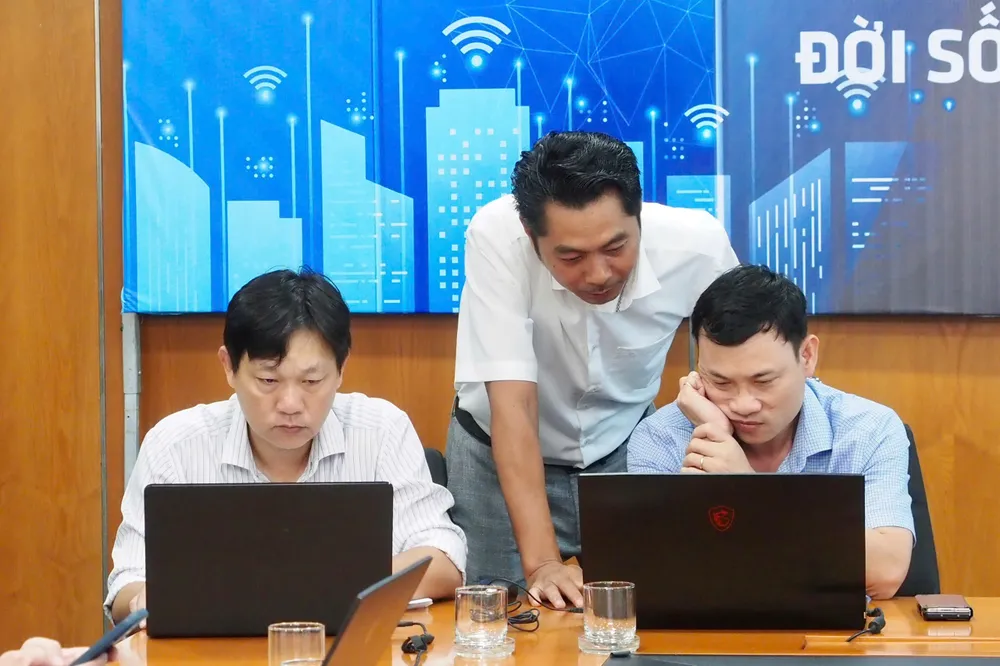
Sir, how will VNPT ensure economic efficiency when deploying 5G in less populated areas such as rural and suburban areas? Is there any solution to both achieve coverage and not lose money?

To ensure economic efficiency when deploying 5G in less populated areas such as rural and suburban areas, VNPT has been actively promoting the following solutions:
- Increase coverage area, through increasing transmission capacity and using low-band frequency bands to reduce the number of stations that need to be invested, but at the same time ensure service quality.
- Promote brand recognition, deploy sales activities to existing resident groups to increase revenue/investment cost efficiency.
- Using digital solutions and applying high technology in automating station operations, helps reduce operating costs per station.
Basically, VNPT manages overall efficiency, not just each station. Use revenue to cover expenses. Welcoming the opportunity. Some stations with political missions must still exist...
Currently, the Center is developing many online public services. So how will 5G be applied to make those services faster and more stable, especially for services that need high speed and low latency?

Determining that high speed is necessary and fundamental in the current period, operating requirements on the 5G platform will be set right from the product design and development stage.
How does the Department of Science and Technology of Ho Chi Minh City plan to coordinate with telecommunications businesses and solution businesses to promote 5G application in high-tech parks, industrial parks and smart urban areas in the new city after the merger?

On April 1, 2025, the Government issued Resolution No. 71/NQ-CP promulgating the Action Program to implement Resolution No. 57-NQ/TW dated December 22, 2024 of the Politburo on breakthrough development of science, technology, innovation and national digital transformation.
In particular, the content of developing 5G mobile information networks is one of the technical foundations to effectively implement the goals of Resolution No. 57-NQ/TW, especially in digital transformation and digital infrastructure development.
Implementing the above Resolutions, the city has issued action plans No. 459-KH/TU and No. 4354/KH-UBND which determine the goal of completing the deployment of 5G network coverage to 100% of the city's population.
Therefore, the Department of Science and Technology has been coordinating with telecommunications businesses to deploy and initially achieve some results as follows: Ho Chi Minh City (old) has developed 2,613 5G BTS stations, accounting for more than 20% of the total number of 5G BTS stations nationwide, meeting more than 40% of the 5G coverage need for city residents. The speed of providing internet access services via 5G network reaches from 300Mbps to 400Mbps compared to the regulated speed of more than 100Mbps.
For high-tech parks, concentrated information technology parks or industrial parks and export processing zones with many organizations and businesses operating, these places have been given priority by telecommunications businesses to develop high-speed 5G network infrastructure as well as fiber optic cable infrastructure for high-speed and ultra-high-speed broadband transmission of more than 1Gbps.
Sir, in the process of expanding the 5G network, what measures will the Department take to ensure information safety and security, especially when the number of IoT-connected devices is increasing rapidly?

The sharp increase in the number of IoT devices does not mean a loss of information security. The Department of Science and Technology will coordinate closely with information security management authorities such as Ho Chi Minh City Police and network operators to implement security standards right from the network infrastructure, require terminal equipment inspection, and promote businesses to apply encrypted transmission technology and real-time network monitoring to ensure data safety.
At the same time, the Department of Science and Technology will coordinate with relevant units to guide, propagate and advise units and people to take measures and apply technical safety standards prescribed by the Government, Ministry of Science and Technology and competent units to ensure information safety and security during the process of deploying, expanding, connecting and using 5G networks and IoT applications.
Sir, in the current Ho Chi Minh City area - including the Binh Duong and Ba Ria - Vung Tau areas - does VNPT have any plans to cooperate with any businesses to develop 5G applications to serve industry, logistics and production infrastructure?

After the merger, Ho Chi Minh City includes Binh Duong and Ba Ria - Vung Tau (old). In fact, between these regions there are certain disparities in telecommunications infrastructure, including both terrestrial mobile and fixed broadband infrastructure. However, the difference is not too large, because in recent years, all three places have been key economic regions in the South, always receiving systematic investment attention from VNPT, meeting the needs of executive direction, socio-economic development and serving the people.
From now until the end of 2025, VNPT will focus on restructuring the overall telecommunications network of Ho Chi Minh City, ensuring data connectivity, infrastructure synchronization and optimizing network capacity, effectively serving digital government, digital economy and digital society.
In particular, in the areas that used to be Binh Duong and Ba Ria - Vung Tau provinces, which have a large density of industrial parks, seaports, and warehouses, VNPT not only promotes 5G coverage but also introduces and provides digital transformation solutions for governments, businesses and people to improve operational and management performance and better serve local development.
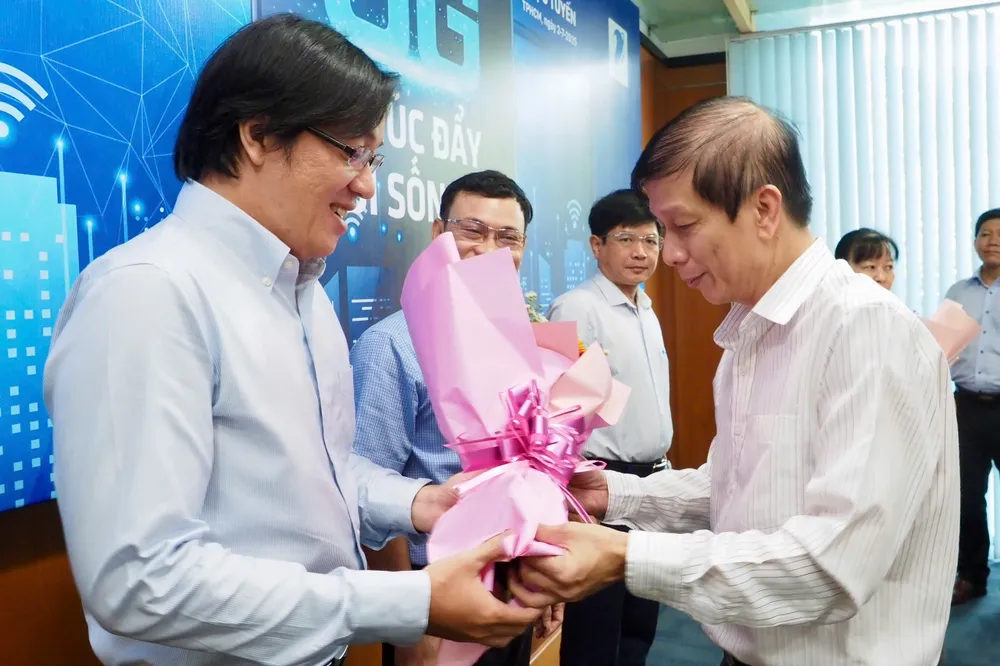
Could you please give your opinion on the development of 5G mobile networks in Vietnam recently? What are the things you're most proud of and what areas need improvement?

In recent times, Vietnam has made significant progress in developing and deploying 5G technology. Although challenges remain, the Government's commitment and the efforts of network operators have created a solid foundation for the future of the digital era. Some specific examples:
- Infrastructure Deployment and Coverage Progress: Vietnam has officially commercialized 5G, with major carriers such as Viettel, VNPT (VinaPhone) and MobiFone actively deploying infrastructure.
Number of 5G BTS stations: By the end of the first quarter of 2025, Vietnam has installed 10,600 5G BTS stations. The Government's goal is to strive to deploy at least 55,000 new 5G broadcasting stations in 2025.
Coverage area: Viettel has deployed 5G in 34 provinces and cities nationwide. VinaPhone and MobiFone are also expanding coverage in big cities such as Hanoi and Ho Chi Minh City, and gradually expanding to other provinces (Source: Law Library, Moi Newspaper). - Network Speed and Quality: 5G speed in Vietnam has improved significantly after major carriers increased deployment and commercialization.
National average speed (April 2025) : 5G network achieved an average speed of 354.88 Mbps for download and 94.92 Mbps for upload. This is the strongest improvement since February 2024 (Source: Dan Tri Newspaper, VnExpress).
Speed by carrier (April 2025) : Viettel is the carrier with the best 5G speed with 364.42 Mbps (download) and 97.6 Mbps (upload). VNPT and MobiFone reached 158.68 Mbps and 162.82 Mbps respectively (Source: VnExpress). - Number of Subscribers 5: The number of 5G users in Vietnam is growing rapidly after carriers promote commercialization.
Viettel: In early March 2025, Viettel announced there were 5.5 million 5G users. By April 2025, this number will increase to 6.2 million 5G users (Source: VnEconomy, Dan Tri Newspaper).
VinaPhone: Reach 3 million 5G users by early March 2025 (Source: VnExpress).
MobiFone: Provide 5G from the end of March 2025 and reach 2.5 million users after one month of deployment (Source: VnExpress). - Role of the Government and Development Direction: The Government of Vietnam has shown a strong leadership role in promoting 5G, learning from the experiences of pioneering countries:
Clear Strategy and Goals: The Ministry of Information and Communications has set a target of 5G coverage for more than 99% of the population by 2030 and reaching 90 million 5G subscribers (Source: GSMA, mic.gov.vn).
Spectrum Allocation Policy: Vietnam has successfully auctioned the 2.6 GHz and 3.5 GHz spectrum for 5G, opening up opportunities to deploy 5G networks on a large scale (Source: mic.gov.vn).
Investment Support : Resolution 193/2025/QH15 and Decree No. 88/2025/ND-CP stipulate financial support policies for telecommunications businesses. Specifically, carriers that deploy 20,000 new 5G BTS stations in 2025 will be supported with 15% of the total investment value (Source: VnExpress, vneconomy.vn). This demonstrates the Government's strong commitment to reducing the cost burden on network operators.
Promoting Commercialization and Application: The Government is promoting 5G commercialization to promote economic growth and encourage 5G application in areas such as industrial production, seaports, mining, and smart transportation (Source: qdnd.vn). Turning off 2G waves is also a strategic step to optimize spectrum resources for 4G and 5G.
In summary, the development of 5G in Vietnam in recent times shows a positive picture with infrastructure gradually expanding, network speed improving and the number of subscribers growing rapidly. The Government's leading role through investment support policies, reasonable spectrum allocation and clear goals is a key factor in promoting this process. Although there are still challenges in cost and coverage optimization, Vietnam is on the right track for 5G to become a solid foundation for the development of digital life and digital economy in the future.
Sir, how does the Center plan to coordinate with telecommunications businesses to promote the development of a digital service ecosystem based on the 5G network, to better serve people and businesses in Ho Chi Minh City?

Ho Chi Minh City Digital Transformation Center always wants to accompany and be ready to receive new solutions and products on the 5G platform at the pilot stage to evaluate and propose application in the city to enrich and diversify digital products and services to serve people and businesses in the spirit of Resolution 57-NQ/TW.
Sir, how does the Department of Science and Technology coordinate with telecommunications businesses like VNPT in deploying and expanding 5G coverage, as well as improving service quality for people and businesses in Ho Chi Minh City?

Ho Chi Minh City (new) officially operates a 2-level local government from July 1, 2025, so the Department of Science and Technology organizes a comprehensive review of 5G infrastructure in this area as soon as possible to fully assess the current situation to come up with appropriate solutions to promote 5G infrastructure development to ensure completion ahead of schedule for the goal of 5G coverage in Ho Chi Minh City (new).
It is expected that in the third quarter of 2025, the Department of Science and Technology will submit to the Ho Chi Minh City People's Committee for approval the 5G infrastructure development plan for the period 2025 - 2027 aiming to cover more than 90% of Ho Chi Minh City, of which 100% of the areas are high-tech parks, industrial parks, export processing zones, administrative centers and densely populated areas.
In 2025, the Department of Science and Technology directs mobile telecommunications businesses to prioritize the deployment of expanding 5G coverage in areas with high demand and key areas such as: public administrative areas; historical - cultural relics, key tourist areas; medical facilities; colleges and universities; traffic hub; densely populated areas, commercial centers, key rural areas; high-tech parks, centralized information technology parks, industrial parks, export processing zones, railway stations, ports, airports... and has quality mobile broadband Internet access service with download speed via 5G network from 100Mbit/s - 500Mbit/s.
Sir, how many BTS stations has VNPT installed for the 5G network currently? And which specific areas has this network covered? Where can people and businesses use it?

By the end of 2024, VNPT has deployed 3,000 5G radio stations nationwide. By the end of 2025, it is expected to have 20,000 stations. VNPT has nationwide coverage (34 provinces and new cities).
VNPT focuses on deploying 5G in the direction of improving user experience and promoting digital transformation, especially focusing on practical applications such as smart cities and industry 4.0. VNPT's strategy is to not only provide high-speed connection but also develop value-added services based on 5G, aiming to become a leading digital service provider.
Specifically, VNPT is focusing on the following aspects:
Expanding 5G coverage:
VNPT is actively deploying 5G broadcasting stations to ensure widespread coverage, especially in urban areas and industrial parks.
5G service development:
VNPT not only provides 5G connectivity but also focuses on developing value-added applications and services on the 5G platform, including solutions for smart cities, industry 4.0, smart health, smart education,...
Enhance user experience
VNPT aims to bring the best 5G experience to users, with high speed, low latency and high reliability.
I would like to ask you: Compared to other countries in the region and around the world, where is Vietnam's 5G network currently standing? What level am I at in terms of coverage, speed or application level?

Based on recently updated reports and data, the position of Vietnam's 5G mobile network can be assessed compared to other countries in the region and the world as follows:
- About 5G Speed: Vietnam is making significant improvements in 5G speed, achieving positive positions on the global and regional maps.
Global : According to a report by VnExpress and Thanh Nien in March 2025 (based on data from Ookla or similar statistical sources), Vietnam's overall mobile internet speed (including 4G and 5G) has reached the Top 20 or Top 22 countries with the fastest mobile internet in the world. Although this figure is a composite of both 4G and 5G, the improvement of 5G contributes greatly to this position.
More specifically about 5G, according to VNNIC (Vietnam Internet Center), the average speed of the nationwide 5G network in April 2025 reached 354.88 Mbps when downloading and 94.92 Mbps when uploading (Source: Dan Tri Newspaper, VnExpress). This is a very good speed, competitive with many developed countries.
Southeast Asia : In the Southeast Asia region, Vietnam is rising strongly. Countries like South Korea and Singapore are still the leaders in global and regional 5G speeds. However, Vietnam is gradually catching up and even surpassing some countries in actual 5G speed.
Some older data sources (Q3-2021) from Ookla may show that Thailand and the Philippines had wider 5G coverage than Vietnam at that time. However, with recent rapid deployment and commercialization, Vietnam has significantly narrowed the gap in both speed and coverage. Vietnam's current average speed of 354.88 Mbps is very competitive in the region, placing Vietnam in the group of countries with the best 5G speeds in ASEAN.
2. About Coverage Area and Deployment Scale
In terms of deployment scale and coverage area , Vietnam is making rapid progress, but still needs more time to catch up with markets that have deployed 5G early and strongly.
China and South Korea: Still the two leading countries in the world in terms of number of 5G base stations and coverage area. China has millions of 5G stations, while South Korea has a very high coverage ratio and number of 5G subscribers per total population. Vietnam has a long way to go to reach this level.
In Southeast Asia: Thailand , Singapore, and the Philippines are countries where 5G has been widely deployed early. However, Vietnam has been accelerating significantly. With a target of 55,000 new 5G broadcasting stations in 2025 (Source: Government Report, VnExpress) and having 10,600 5G BTS stations by the end of the first quarter of 2025, Vietnam is showing strong determination to expand coverage.
3. Regarding the Number of 5G Subscribers: The number of 5G subscribers in Vietnam is growing impressively after carriers commercialized the service.
According to statistical reports as of April 2025, Vietnam has about 6.2 million 5G subscribers of Viettel, 3 million of VinaPhone, and 2.5 million of MobiFone (Source: VnEconomy, VnExpress, Dan Tri Newspaper). In total, there are more than 11 million 5G subscribers after just a few months of intense commercialization.
Compared with larger markets and earlier deployment, this number shows that Vietnam is having a very good subscriber growth rate. GSMA (World Mobile Communications Association) forecasts that Southeast Asia will have about 680 million 5G subscribers by the end of 2030 (Source: tinnhanhchungkhoan.vn). With Vietnam's target of 90 million 5G subscribers by 2030 (Source: GSMA, mic.gov.vn), Vietnam is expected to account for a significant portion of the region's total 5G subscriptions.
So overall, Vietnam's 5G mobile network is in a quite good position and has a rapid growth rate compared to other countries in Southeast Asia, especially in terms of network speed . In terms of coverage area and number of subscribers , Vietnam is on track to catch up and will become one of the leading 5G markets in the region in the coming years, thanks to the strong commitment of the Government and the investment efforts of carriers. However, continued efforts are still needed to be on par with the world's leading 5G powers such as Korea or China in terms of both technological depth and comprehensive coverage.
How has the Ho Chi Minh City Digital Transformation Center built a strategy to take advantage of 5G infrastructure to serve the city's digital transformation programs in the period 2025–2030, sir?

Việc xây dựng, tham mưu chiến lược, chương trình, kế hoạch chuyển đổi số nói chung và phát triển hạ tầng số, hạ tầng viễn thông sẽ do Sở KH-CN TPHCM chủ trì. Trung tâm Chuyển đối số là đơn vị phối hợp, đề xuất các nội dung liên quan. Đối với các ứng dụng số do trung tâm triển khai trong thời gian tới, công nghệ 5G sẽ là yêu cầu cần đáp ứng.
Lãnh đạo VNPT có thể chia sẻ cụ thể: hiện đã có nhà máy, xưởng, hay cảng nào đang dùng 5G của VNPT chưa? Các bên này đang dùng 5G vào việc gì – điều khiển thiết bị, giám sát, tự động hóa? Hiệu quả bước đầu thế nào rồi ạ?

Ngoài khách hàng cá nhân, hiện nay VNPT đã có các khách hàng là các doanh nghiệp kinh doanh trong lĩnh vực cung cấp truyền tải điện, nước sạch, nông nghiệp thông minh.
Ví dụ: IoT 5G VNPT hợp đồng với điện lực HCM để quản lý các tủ điện.
IoT với cấp nước TPHCM để quản lý đồng hồ nước từ xa.
Các IoT cho nông nghiệp; dự án chống biến đổi khí hậu; các IOC cho các tỉnh, TP.
Các giải pháp theo dõi đoàn xe cho các DN Logistics...
Hiệu quả rất tốt.
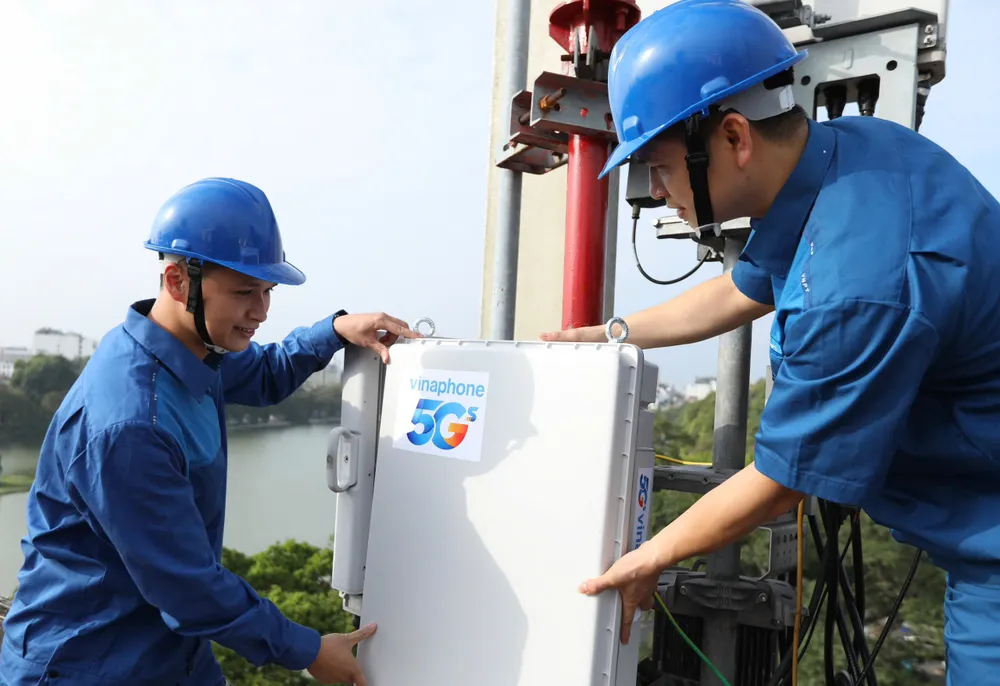
Thưa ông, sau khi TPHCM hợp nhất với Bình Dương và Bà Rịa - Vũng Tàu, Sở sẽ ưu tiên những giải pháp gì để đồng bộ hóa hạ tầng viễn thông và thúc đẩy chuyển đổi số giữa các địa phương này?

Hạ tầng kỹ thuật viễn thông thụ động trong đó có hạ tầng mạng 5G tại TPHCM, Bình Dương và Bà Rịa – Vùng Tàu trước khi hợp nhất được thực hiện theo Quy hoạch của từng địa phương, cụ thể:
- Tại TPHCM thực hiện theo Quyết định số 3192/QĐ-UBND ngày 23-6-2016.
- Tại Bình Dương thực hiện theo Quyết định số 2200/QĐ-UBND ngày 25-8-2016.
- Tại Bà Rịa – Vũng Tàu thực hiện theo Quyết định số 1771/QĐ-UBND ngày 21-8-2016.
Quá trình sáp nhập 3 địa phương Bình Dương, Bà Rịa – Vũng Tàu và TPHCM đi vào hoạt động từ ngày 1-7-2025 nên Sở KH-CN tổ chức rà soát tổng thể hạ tầng 5G tại TPHCM mới trong thời gian sớm nhất để có thể đánh giá đầy đủ thực trạng, đưa ra giải pháp phù hợp nhằm thúc đẩy phát triển hạ tầng 5G đảm bảo hoàn thành trước thời hạn đối với mục tiêu phủ sóng 5G cho toàn địa TPHCM mới.
Trên cơ sở Luật Viễn thông số 24/2023/QH15, Nghị định số 163/2024/NĐ-CP, các quy định liên quan về hướng dẫn lập quy hoạch hạ tầng kỹ thuật viễn thông thụ động và kết quả rà soát tổng thể hiện trạng, Sở KH-CN sẽ phối hợp các đơn vị liên quan tham mưu UBND TPHCM xem xét phê duyệt Quy hoạch hạ tầng kỹ thuật viễn thông tại TPHCM giai đoạn 2025 – 2030, tầm nhìn đến năm 2035 một cách đồng bộ, thống nhất trên toàn địa bàn TPHCM mới.
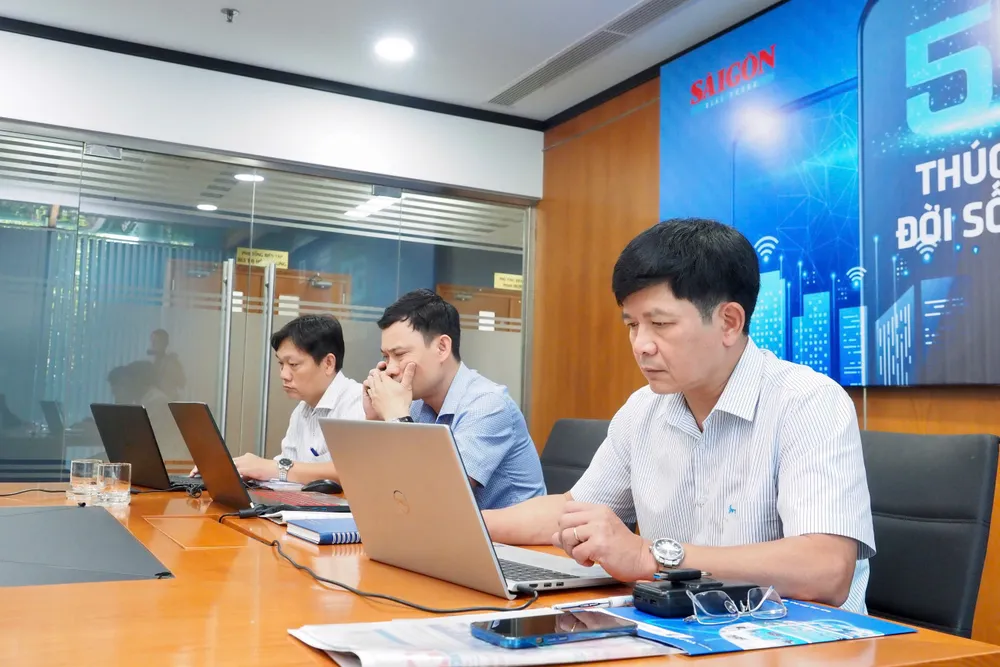
Thưa ông, Sở KH-CN TPHCM có lộ trình cụ thể nào để đảm bảo mục tiêu phủ sóng 100% mạng 5G trên toàn địa bàn TPHCM mới, bao gồm cả các khu vực vừa sáp nhập, không ạ?

Theo định hướng phát triển cơ sở hạ tầng viễn thông của Chính phủ tại Nghị quyết số 71/NQ-CP về ban hành Chương trình hành động thực hiện Nghị quyết số 57-NQ/TW ngày 22-12-2024 của Bộ Chính trị về đột phá phát triển khoa học, công nghệ, đổi mới sáng tạo và chuyển đổi số quốc gia và Quy hoạch hạ tầng thông tin và truyền thông tại Quyết định số 36/QĐ-TTg ngày 11-1-2024 thì mục tiêu đến năm 2030, mạng băng rộng di động 5G phủ sóng 99% dân số cả nước, chất lượng dịch vụ tốc độ tải xuống trung bình tối thiểu của mạng 5G là 100Mb/s.
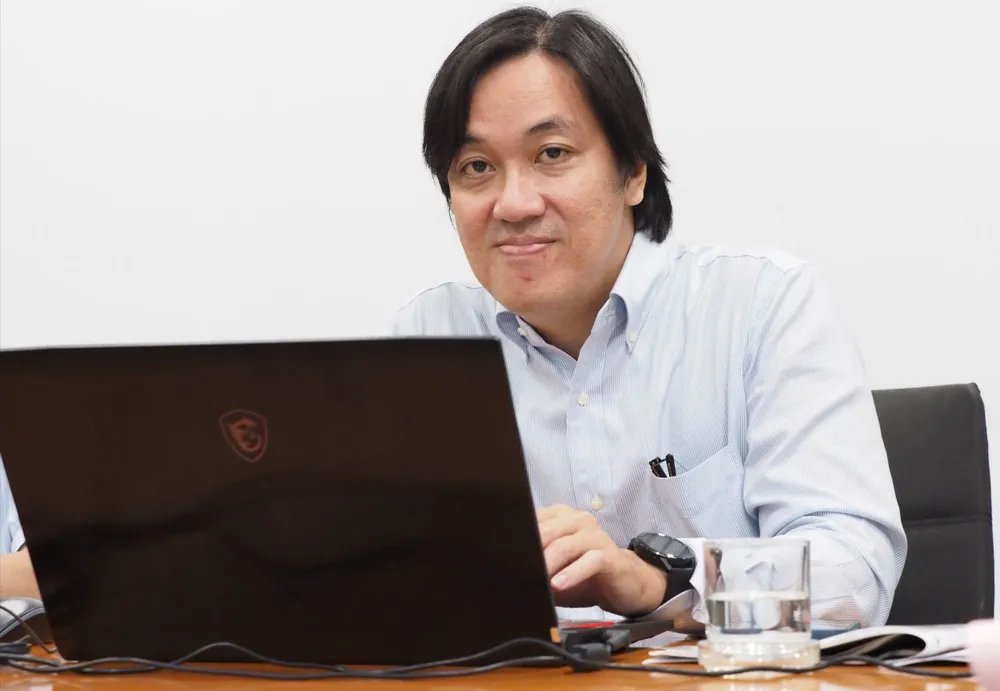
TPHCM (mới) chính thức vận hành chính quyền địa phương 2 cấp từ ngày 1-7-2025 nên Sở KH-CN tổ chức rà soát tổng thể hạ tầng 5G tại địa bàn này trong thời gian sớm nhất để có thể đánh giá thực trạng, đưa ra giải pháp phù hợp nhằm thúc đẩy phát triển hạ tầng 5G đảm bảo hoàn thành trước thời hạn đối với mục tiêu phủ sóng 5G cho toàn địa bàn TPHCM (mới).
Dự kiến trong quý 3-2025, Sở KH-CN sẽ trình UBND TPHCM phê duyệt kế hoạch phát triển hạ tầng 5G giai đoạn 2025 – 2027 hướng đến mục tiêu phủ sóng hơn 90% địa bàn TPHCM, trong đó 100% các khu vực là khu công nghệ cao, khu công nghiệp, khu chế xuất, trung tâm hành chính và các khu vực tập trung đông dân cư.
Việc đầu tư mạng 5G vừa yêu cầu kỹ thuật cao vừa cần bài toán kinh tế lớn. Vậy xin lãnh đạo VNPT cho biết: chiến lược phát triển 5G sắp tới của VNPT là gì, và sẽ được triển khai ra sao để cân bằng giữa hiệu quả và chi phí?

VNPT tập trung vào việc triển khai 5G theo hướng nâng cao trải nghiệm người dùng và thúc đẩy chuyển đổi số, đặc biệt tập trung vào các ứng dụng thực tế như thành phố thông minh và công nghiệp 4.0. Chiến lược của VNPT là không chỉ cung cấp kết nối tốc độ cao mà còn phát triển các dịch vụ giá trị gia tăng dựa trên 5G, hướng tới mục tiêu trở thành nhà cung cấp dịch vụ số hàng đầu.
Cụ thể, VNPT đang tập trung vào các khía cạnh sau:
Mở rộng vùng phủ sóng 5G:
VNPT đang tích cực triển khai các trạm phát sóng 5G để đảm bảo vùng phủ sóng rộng khắp, đặc biệt tại các khu vực đô thị và khu công nghiệp.
Phát triển dịch vụ 5G:
VNPT không chỉ cung cấp kết nối 5G mà còn tập trung vào phát triển các ứng dụng và dịch vụ giá trị gia tăng trên nền tảng 5G, bao gồm các giải pháp cho thành phố thông minh, công nghiệp 4.0, y tế thông minh, giáo dục thông minh,...
Enhance user experience
VNPT đặt mục tiêu mang đến trải nghiệm 5G tốt nhất cho người dùng, với tốc độ cao, độ trễ thấp và độ tin cậy cao.
Hợp tác với các đối tác:
VNPT hợp tác với các đối tác trong và ngoài nước để phát triển các giải pháp và dịch vụ 5G, đồng thời chia sẻ kiến thức và kinh nghiệm.
VNPT xác định 5G là một yếu tố quan trọng trong quá trình chuyển đổi số của Việt Nam, và VNPT cam kết sẽ đầu tư mạnh mẽ vào công nghệ này để đáp ứng nhu cầu ngày càng cao của khách hàng và góp phần vào sự phát triển kinh tế - xã hội của đất nước.

Trong Nghị quyết 57 của Bộ Chính trị, Nghị quyết số 193/2025/QH15 của Quốc hội và mới đây là danh mục các công nghệ chiến lược do Chính phủ vừa ban hành, phát triển công nghệ mạng 5G được nhấn mạnh và ưu tiên. Điều này có ý nghĩa như thế nào?

Việc phát triển công nghệ mạng 5G được nhấn mạnh và ưu tiên trong các văn bản quan trọng của Việt Nam như Nghị quyết 57 của Bộ Chính trị, Nghị quyết số 193/2025/QH15 của Quốc hội và danh mục các công nghệ chiến lược do Chính phủ ban hành, mang ý nghĩa sâu sắc và đa chiều, thể hiện tầm nhìn chiến lược của Việt Nam trong kỷ nguyên số.
- Khẳng định 5G là Trụ cột Phát triển Quốc gia: Việc đưa 5G vào các văn bản cấp cao nhất (Bộ Chính trị, Quốc hội, Chính phủ) cho thấy đây không chỉ là một công nghệ đơn thuần mà là một trụ cột chiến lược cho sự phát triển của đất nước. Điều này ngụ ý rằng 5G được coi là yếu tố nền tảng để thúc đẩy:
- Kinh tế số: 5G sẽ tạo ra động lực mới cho các ngành công nghiệp, dịch vụ và mô hình kinh doanh số, đóng góp vào tăng trưởng GDP.
- Xã hội số: Cải thiện chất lượng cuộc sống, cung cấp các dịch vụ công tiện ích hơn, thu hẹp khoảng cách số.-
- Chính phủ số: Nâng cao hiệu quả quản lý, điều hành của nhà nước thông qua việc ứng dụng các công nghệ kết nối tiên tiến. - Cam kết Mạnh mẽ của Chính phủ và Hệ thống Chính trị: Sự ưu tiên này thể hiện cam kết mạnh mẽ và quyết tâm cao của toàn bộ hệ thống chính trị Việt Nam trong việc đầu tư và phát triển 5G. Điều này sẽ tạo ra một môi trường thuận lợi để:
- Thu hút đầu tư : Các nhà mạng và doanh nghiệp công nghệ sẽ tự tin hơn khi đầu tư vào hạ tầng và ứng dụng 5G, biết rằng họ có sự ủng hộ từ cấp cao nhất.
- Phối hợp liên ngành: Các bộ, ban, ngành sẽ có trách nhiệm và động lực để phối hợp chặt chẽ hơn trong việc tháo gỡ rào cản, ban hành chính sách hỗ trợ, đảm bảo sự đồng bộ trong triển khai.
- Chủ động về công nghệ: Việt Nam không chỉ muốn là người sử dụng công nghệ mà còn hướng tới làm chủ và phát triển công nghệ 5G, đặc biệt là các thiết bị và giải pháp. - Tạo Điều kiện Thuận lợi cho Triển khai và Ứng dụng: Việc được xếp vào danh mục công nghệ chiến lược sẽ mở ra nhiều cánh cửa hỗ trợ thiết thực:
- Phân bổ nguồn lực: Chính phủ sẽ ưu tiên phân bổ ngân sách, phổ tần, và các nguồn lực khác cho việc phát triển 5G.
- Chính sách ưu đãi: Có thể có thêm các chính sách cụ thể về thuế, tín dụng, quy hoạch hạ tầng để hỗ trợ các nhà mạng và doanh nghiệp công nghệ. Nghị quyết số 193/2025/QH15 đã minh chứng điều này bằng việc đưa ra các chính sách hỗ trợ tài chính cho doanh nghiệp viễn thông triển khai trạm BTS 5G.
- Thúc đẩy ứng dụng đặc thù: Việc ưu tiên này sẽ khuyến khích các ngành kinh tế trọng điểm (sản xuất thông minh, y tế, giao thông) chủ động thử nghiệm và triển khai các ứng dụng 5G, tạo ra và mở rộng nhu cầu thị trường đối với công nghệ này. - Nâng cao Vị thế và Năng lực Cạnh tranh Quốc gia. Trong bối cảnh cạnh tranh công nghệ toàn cầu, việc Việt Nam ưu tiên 5G là một tuyên bố mạnh mẽ về vị thế của mình:
- Nâng cao năng lực cạnh tranh : Một hạ tầng 5G vững chắc sẽ giúp Việt Nam hấp dẫn hơn trong mắt các nhà đầu tư nước ngoài, đặc biệt là trong lĩnh vực công nghệ cao và sản xuất thông minh.
- Khẳng định vai trò khu vực : Việt Nam sẽ củng cố vị trí của mình như một quốc gia năng động trong chuyển đổi số tại khu vực Đông Nam Á và châu Á.
- Chủ quyền số: Phát triển công nghệ 5G trong nước cũng góp phần đảm bảo an ninh thông tin và chủ quyền số, giảm sự phụ thuộc vào công nghệ nước ngoài. - Chuẩn bị cho Tương lai Kỷ nguyên số Toàn diện: Sự ưu tiên này là một bước chuẩn bị chiến lược cho tương lai, nơi 5G sẽ là xương sống cho:
- Kỷ nguyên AI và Dữ liệu lớn: Đảm bảo khả năng kết nối và xử lý dữ liệu khổng lồ theo thời gian thực.
- Thực tế ảo/Thực tế tăng cường (VR/AR) và Metaverse: Tạo nền tảng cho các trải nghiệm số nhập vai và thế giới ảo trong tương lai.
- Tự động hóa toàn diện: Mở đường cho các thành phố thông minh, nhà máy thông minh và hệ thống giao thông tự động hóa ở quy mô lớn.
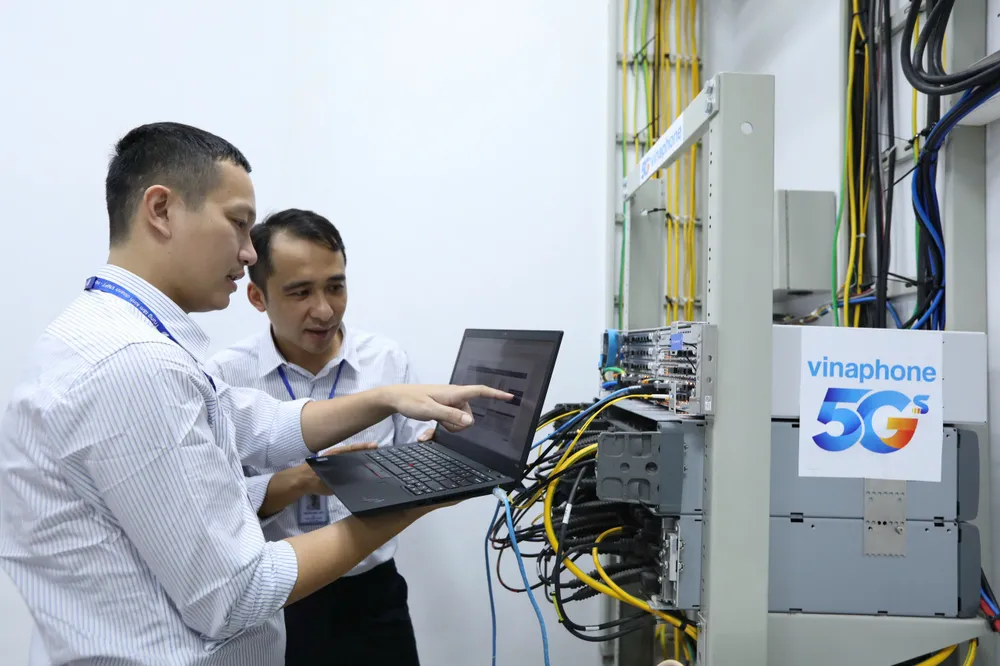
Tóm lại, việc 5G được nhấn mạnh và ưu tiên trong các văn bản cấp cao nhất của Việt Nam không chỉ là một tuyên bố mang tính biểu tượng mà còn là kim chỉ nam hành động quan trọng, thể hiện quyết tâm của Việt Nam trong việc xây dựng một hạ tầng số hiện đại, vững chắc, làm nền tảng cho sự phát triển bứt phá về kinh tế - xã hội trong thời gian tới.
Thưa ông, ông có thể cho biết Trung tâm sẽ hỗ trợ các phường, xã như thế nào để tận dụng công nghệ 5G trong quản lý, điều hành và kết nối chính quyền số đến tận khu phố, ấp không ạ?

Với chức năng và nhiệm vụ được UBND TPHCM giao, Trung tâm Chuyển đổi số phối hợp, tư vấn các phường, xã trong xây dựng và triển khai hệ thống hạ tầng số, hạ tầng mạng để đáp ứng các yêu cầu về vận hành thông suốt các ứng dụng ngay thời điểm ngày 1-7-2025.
Bên cạnh hạ tầng mạng cáp quang, trung tâm sẽ phối hợp các các chuyên gia, đơn vị tư vấn xây dựng mô hình mạng di động không dây hiện đại, tiện lợi và an toàn. Sắp tới, trung tâm sẽ triển khai ứng dụng hỗ trợ, quản lý, điều hành phường, xã, khu phố, ấp. Ứng dụng này sẽ được xây dựng, triển khai trên nền tảng công nghệ 5G.
Ngoài ra, trung tâm mong muốn có sự hợp tác, hỗ trợ từ các phường, xã trong quá trình vận hành và triển khai chuyển đổi số để thực hiện hiệu quả mục tiêu chuyển đổi số tại TPHCM.
Thưa ông, xin ông cho biết so sánh về lợi thế và hạn chế của ba nhà mạng lớn đang triển khai 5G tại Việt Nam là VNPT, Viettel và MobiFone trong việc phát triển và cung cấp dịch vụ 5G? Nhà mạng nào đang dẫn đầu và đâu là những điểm cần cải thiện?

Với hiện trạng hạ tầng mạng 5G hiện nay, định hướng mang tầm chiến lược của đảng và nhà nước trong việc thúc đẩy đổi mới khoa học công nghệ, thúc đẩy chuyển đổi số theo hướng hiệu lực, hiệu quả. Cả 3 nhà mạng với quy mô hạ tầng rộng khắp, đều có cơ hội trong việc mở rộng đầu tư, đẩy mạnh nghiên cứu ứng dụng 5G vào đời sống, góp phần hoàn thành mục tiêu chung của đất nước. Khó khăn theo tôi thì vẫn là khó khăn chung, các nhà mạng đều phải đối mặt và giải quyết đó là: Bài toán chi phí hiệu quả đầu tư, thói quen của người dân, và sự trưởng thành của doanh nghiệp trong việc ứng dụng các thành quả của chuyển đổi số, hạ tầng số vào các hoạt động sản xuất kinh doanh hàng ngày.
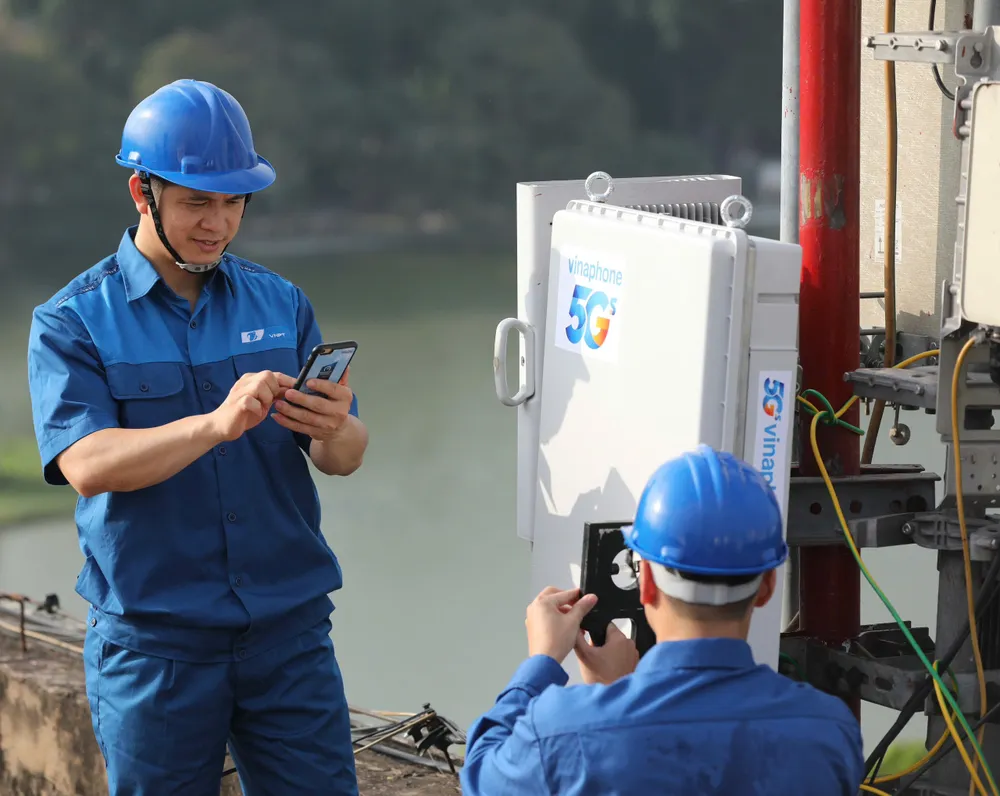
Tuy nhiên, Vinaphone có 3 lợi thế lớn:
1.Quản lý hạ tầng viễn thông lâu đời về hầm cống, cáp quang, mạng lõi, mạng cáp quang biển nên khi xây dựng mạng 5G nhanh chóng và chất lượng hơn;
2. Đội ngũ quản lý, quản trị lâu năm để BTBD và CSKH tốt hơn;
3.Là tập đoàn công nghệ, cung cấp hệ sinh thái và các sản phẩm CNTT, Clouding; IoT phù hợp với các hạ tầng 5G.
Em nghe nói VinaPhone đã phủ sóng 5G khắp các tỉnh, thành, nhất là ở các khu trung tâm hành chính, bệnh viện, sân bay… Anh/chị có thể chia sẻ thêm: người dân ở các khu vực nông thôn hay ngoại thành đã dùng được 5G chưa, và nếu thiết bị hỗ trợ thì có tự động kết nối được không?

Đến cuối năm 2024, VNPT đã triển khai 3.000 trạm vô tuyến 5G trên toàn quốc. Cuối năm 2025, toàn mạng sẽ có khoảng 20.000 trạm.
Khu vực nông thôn, ngoại thành cũng đã có phủ sóng 5G Vinaphone. Tuy nhiên chưa dày đặc như ở thành phố vì chính sách ưu tiên và bài toán hiệu quả đầu tư. Ngoài ra còn phụ thuộc nhu cầu thực tế của thị trường.
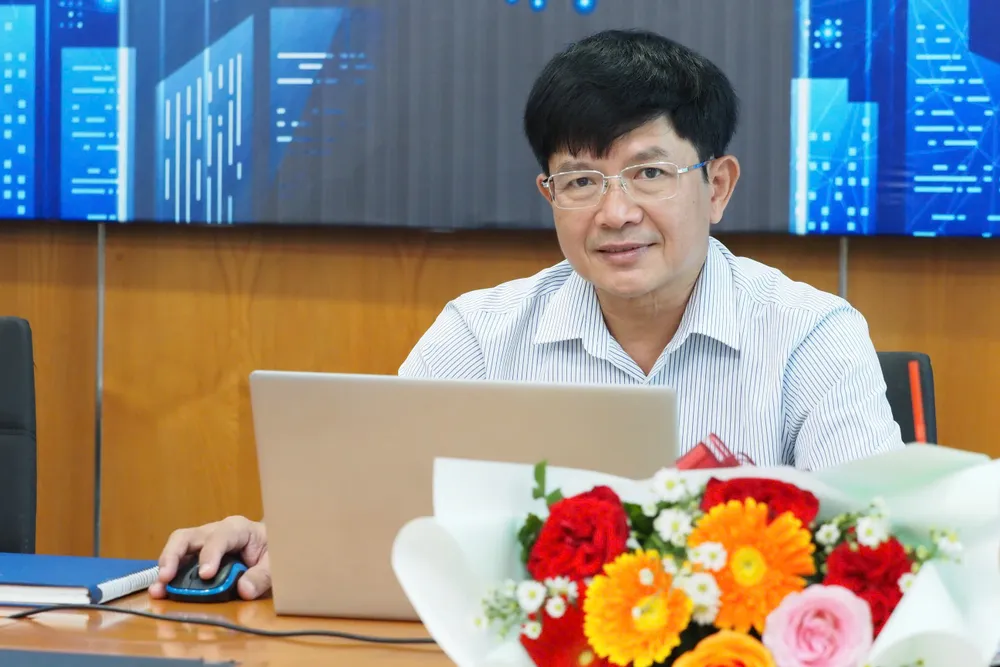
5G nghe rất hiện đại, nhưng thực tế người dùng bình thường như tụi em chưa thấy khác biệt mấy so với 4G. Liệu mình đang thiếu ứng dụng phù hợp, hay còn 'kẹt' chỗ nào trong hệ sinh thái vậy ạ?

Dù Việt Nam đã có những bước tiến đáng kể trong việc triển khai mạng 5G về mặt hạ tầng và số lượng thuê bao, nhưng thực tế các ứng dụng và hệ sinh thái 5G "độc quyền" – những ứng dụng chỉ có thể phát huy tối đa hoặc hoạt động hiệu quả trên nền tảng 5G, chứ không phải là nâng cấp đơn thuần từ 4G – vẫn còn khá hạn chế. Có nhiều lý do cho tình trạng này:
- Nhu cầu thực tế của người dùng cá nhân chưa đủ mạnh
- 4G vẫn đáp ứng tốt nhu cầu cơ bản: Đối với phần lớn người dùng cá nhân tại Việt Nam, mạng 4G hiện tại với tốc độ và độ ổn định đã đủ để đáp ứng tốt các nhu cầu phổ biến hàng ngày như lướt web, xem video HD (YouTube, TikTok), sử dụng mạng xã hội, bản đồ, ngân hàng điện tử hay thương mại điện tử. Người dùng chưa cảm thấy có nhu cầu cấp thiết phải chuyển sang 5G nếu chỉ để làm những việc tương tự mà 4G đã xử lý được.
- Thiếu ứng dụng đòi hỏi băng thông cao: Trên toàn cầu, việc tìm kiếm một tiêu thụ băng thông cao thực sự khiến người dùng phổ thông phải nâng cấp lên 5G vẫn là một thách thức. Các ứng dụng như VR/AR nhập vai, game online độ trễ cực thấp, hoặc nội dung 8K di động chưa thực sự phổ biến trong đời sống hàng ngày của đa số người dân Việt Nam.
- Hạ tầng 5G còn ở giai đoạn đầu và chưa đồng bộ
- Vùng phủ sóng chưa toàn diện: Mặc dù các nhà mạng đã nỗ lực phủ sóng tại các thành phố lớn và một số khu vực trọng điểm, vùng phủ sóng 5G vẫn chưa rộng khắp và đồng đều như 4G (đạt 99,8% dân số)..
- Chủ yếu là 5G NSA (Non-Standalone): Hầu hết các mạng 5G đang triển khai tại Việt Nam là 5G NSA, nghĩa là vẫn sử dụng lõi mạng 4G LTE. Điều này giúp giảm chi phí triển khai ban đầu và tăng tốc độ, nhưng không thể phát huy hết các tính năng nâng cao của 5G như độ trễ cực thấp (URLLC) hay khả năng cắt lát mạng (network slicing), vốn là nền tảng cho các ứng dụng công nghiệp phức tạp. Để phát triển các ứng dụng độc quyền, cần có hạ tầng 5G SA (Standalone), điều này đòi hỏi đầu tư lớn hơn và thời gian triển khai lâu hơn.
- Tâm lý "chờ đợi và quan sát"
Một bộ phận người dùng và doanh nghiệp có tâm lý "chờ đợi và quan sát" để xem 5G thực sự mang lại lợi ích gì đáng kể so với 4G trước khi đầu tư hoặc chuyển đổi. Họ muốn thấy những dịch vụ thực sự khác biệt, chứ không chỉ là tốc độ nhanh hơn một chút. Ông Võ Đỗ Thắng, Giám đốc Trung tâm Đào tạo An ninh mạng ATHENA, cũng cho rằng "DN cần sự khác biệt giữa 5G so với mạng 4G, 3G hay cáp quang để lựa chọn" (theo NLD).
Thưa ông, xin ông cho biết 5G sẽ được ứng dụng như thế nào trong các dự án thử nghiệm đô thị thông minh, khu công nghệ cao, và khu công nghiệp thông minh mà Trung tâm đang tư vấn và triển khai?

Với xu hướng và đòi hỏi ngày càng cao của người dùng Internet, Trung tâm Chuyển đổi số TPHCM xác định việc ứng dụng công nghệ 5G và các công nghệ di động thế hệ mới là yêu cầu tất yếu và cần thực hiện.
Nếu không áp dụng 5G, vấn đề triển khai các ứng dụng di động có yêu cầu về xử lý dữ liệu lớn, xử lý bản đồ, hình ảnh chất lượng cao, trí tuệ nhân tạo sẽ gặp khó khăn, từ đó sẽ không thu hút hoặc không duy trì được sự quan tâm và sử dụng của người dân thành phố.
Tôi thấy từ hồi có 5G thì mạng 4G của Vinphone cảm giác kém hẳn đi, nhà mạng nên tối ưu, giảm gói cước mạng 4G. Gói 5G tôi mới bấm Speedtest xem tốc độ bao nhiêu thôi, mà mấy giây đi hết 4,4G data. Nhà mạng có thể tư vấn cho tôi vài gói cước dùng lướt mạng xã hội rẻ, xài lướt mạng đọc tin tức đủ 1 ngày?

Chất lượng của mạng 4G (cũng như mạng 5G) của tất cả các nhà mạng hiện đang được Bộ Khoa học và Công nghệ đo kiểm dựa trên các thông số khách quan và công bố kết quả định kỳ trên các phương tiện truyền thông đại chúng. Kết quả này không cho thấy sự khác biệt về chất lượng của mạng 4G trước và sau khi triển khai 5G.

Các gói cước Vinaphone (không phân biệt công nghệ) rất nhiều. Quý vị có thể tìm kiếm dễ dàng trên trang chủ của nhà mạng hoặc search trên Google.
Tương lai 5G, rồi sau này là 6G ở Việt Nam mình có phát triển mạnh được không ạ? Điều này có nằm trong tầm tay mình hay còn phụ thuộc vào những yếu tố bên ngoài nữa? Thank you

Tương lai phát triển của công nghệ 5G và đặc biệt là 6G tại Việt Nam sẽ phụ thuộc vào sự tổng hòa của nhiều yếu tố then chốt. Đây là một cuộc đua công nghệ toàn cầu, và vị thế của Việt Nam sẽ được định đoạt bởi sự kết hợp giữa chính sách vĩ mô, năng lực nội tại và khả năng thích ứng với xu hướng thế giới.
- Vai trò dẫn dắt của Chính phủ và khung pháp lý: Đây là yếu tố quan trọng hàng đầu, đặc biệt đối với một công nghệ mang tính chiến lược quốc gia như 5G và 6G.
- Tầm nhìn và chiến lược quốc gia rõ ràng: Như đã đề cập, việc 5G được ưu tiên trong các Nghị quyết của Bộ Chính trị (Nghị quyết 57), Quốc hội (Nghị quyết 193/2025/QH15) và danh mục công nghệ chiến lược của Chính phủ cho thấy cam kết mạnh mẽ. Đối với 6G, Việt Nam đã đặt mục tiêu sẵn sàng triển khai thử nghiệm mạng di động 6G vào năm 2030 và nghiên cứu công nghệ 6G trong năm 2025. Sự định hướng này tạo tiền đề vững chắc cho các bước đi tiếp theo.
- Chính sách phổ tần: Việc phân bổ phổ tần hợp lý, đủ băng thông cho cả 5G (đặc biệt là dải tần trung) và chuẩn bị cho 6G (như băng tần 3.5 GHz và 6 GHz cho 6G) là cực kỳ quan trọng. Chính phủ cần có lộ trình rõ ràng và linh hoạt trong việc cấp phép, đấu giá để đảm bảo các nhà mạng có đủ tài nguyên triển khai.
- Hỗ trợ đầu tư và thúc đẩy cạnh tranh: Các chính sách ưu đãi tài chính (như hỗ trợ 15% tổng giá trị đầu tư cho 20.000 trạm BTS 5G mới trong năm 2025), đơn giản hóa thủ tục hành chính, và khuyến khích chia sẻ hạ tầng sẽ giảm gánh nặng cho nhà mạng. Đồng thời, duy trì môi trường cạnh tranh lành mạnh giữa các nhà mạng cũng thúc đẩy chất lượng dịch vụ và tốc độ triển khai.
- Hoàn thiện khung pháp lý và tiêu chuẩn: Xây dựng các quy định, tiêu chuẩn kỹ thuật cho các ứng dụng 5G/6G tiên tiến (ví dụ: xe tự lái, y tế từ xa, nhà máy thông minh) là cần thiết để tạo hành lang pháp lý cho doanh nghiệp yên tâm đầu tư và phát triển dịch vụ.
- Năng lực nghiên cứu và phát triển (R&D) và chủ động công nghệ
- Đây là yếu tố quyết định vị thế của Việt Nam trong chuỗi giá trị công nghệ toàn cầu, đặc biệt với 6G.
- Đầu tư vào R&D: Việc thành lập Ban Chỉ đạo thúc đẩy nghiên cứu phát triển công nghệ thông tin di động 6G và khuyến khích các nhà mạng tham gia nhóm nghiên cứu 6G thể hiện nỗ lực ban đầu. Tương lai sẽ phụ thuộc vào việc tăng cường đầu tư thực chất vào các viện nghiên cứu, trường đại học và các trung tâm R&D của doanh nghiệp.
- Phát triển nguồn nhân lực chất lượng cao: 5G và 6G đòi hỏi đội ngũ kỹ sư, chuyên gia có trình độ rất cao về viễn thông, AI, dữ liệu lớn, điện toán biên. Khả năng đào tạo và giữ chân nhân tài sẽ là yếu tố then chốt.
- Hợp tác quốc tế và vị thế trên bản đồ công nghệ thế giới
- Không thể phát triển công nghệ mạng một cách đơn độc trong một thế giới kết nối.
- Tham gia vào quá trình Tiêu chuẩn hóa 6G: Các quốc gia đi đầu đang tích cực định hình các tiêu chuẩn cho 6G. Việt Nam cần tham gia sâu hơn vào các diễn đàn, tổ chức quốc tế để có tiếng nói, cập nhật xu hướng và đảm bảo khả năng tương thích của công nghệ trong nước.
- Hợp tác chuyển giao công nghệ: Học hỏi kinh nghiệm và tiếp nhận chuyển giao công nghệ từ các quốc gia, tập đoàn hàng đầu thế giới sẽ giúp Việt Nam rút ngắn khoảng cách phát triển.
- Thu hút đầu tư nước ngoài: Một môi trường pháp lý rõ ràng, chính sách hỗ trợ và hạ tầng phát triển sẽ thu hút các tập đoàn công nghệ lớn đến đầu tư và phát triển 5G/6G tại Việt Nam.
Tóm lại, tương lai phát triển 5G và 6G tại Việt Nam sẽ do sự phối hợp đồng bộ và hiệu quả giữa Chính phủ, các nhà mạng, cộng đồng doanh nghiệp và viện nghiên cứu quyết định. Chính phủ đóng vai trò định hướng chiến lược, tạo môi trường thuận lợi. Các nhà mạng và doanh nghiệp là lực lượng triển khai, đầu tư và phát triển ứng dụng. Năng lực R&D và nhân lực chất lượng cao sẽ quyết định khả năng làm chủ công nghệ.
Nếu Việt Nam có thể duy trì đà tăng trưởng hiện tại, giải quyết các thách thức về chi phí và hạ tầng, đồng thời tìm ra các ứng dụng thực sự đột phá, chúng ta hoàn toàn có thể trở thành một trong những quốc gia tiên phong trong kỷ nguyên 5G và 6G.
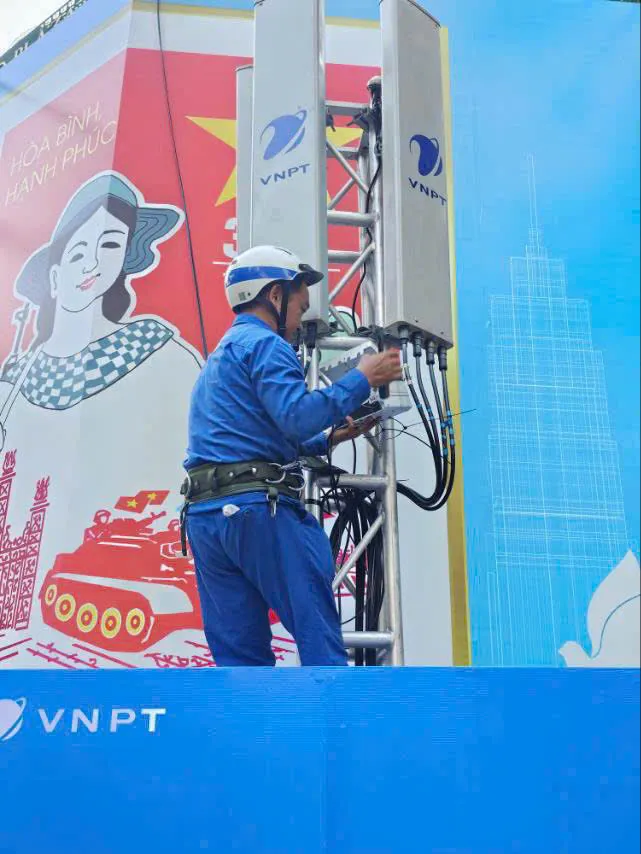
Xin hỏi nhà mạng, với người dùng bình thường, các nhu cầu cơ bản như lướt mạng xã hội, đọc báo, hóng drama thì có cần nâng cấp từ 4G lên gói cước 5G không?

VNPT có rất nhiều các gói cước dịch vụ khác nhau để đáp ứng nhu cầu đa dạng của khách hàng. Nhưng đối với các nhu cầu cơ bản như bạn đặt ra thì (theo quan điểm cá nhân) các gói cước 4G hiện nay hoàn toàn có thể đáp ứng yêu cầu
Tuy nhiên với nhưng tính năng vượt trội (Tốc độ cao và độ trễ thấp) thì quý khách hàng nên trải nghiệm và chắc chắn trong tương lai không xa, quý khách hàng sẽ nhận diện được sự khác biệt với các công nghệ trước đó
HIện Vinaphone không phân biệt gói cước theo công nghệ. Tức là quý vị có thể dùng gói cước hiện tại để trải nghiệm 5G.

Xin lãnh đạo VNPT cho biết, để làm chủ được công nghệ 5G thì cần những điều kiện hay yếu tố gì ạ? Và hiện nay, VNPT đã có bước đi cụ thể nào để thực hiện mục tiêu này chưa? Người dân có thể kỳ vọng gì trong thời gian tới?

Yêu cầu để làm chủ công nghệ mạng 5G
Để làm chủ công nghệ mạng 5G, cần đáp ứng các yêu cầu cốt lõi sau:
1. Phát triển hạ tầng mạng hiện đại :
- Triển khai mạng lưới dựa trên kiến trúc ảo hóa (NFV/SDN), điện toán đám mây và hỗ trợ cả hai mô hình NSA (kế thừa 4G) và SA (độc lập).
- Sử dụng băng tần tối ưu (ví dụ: băng tần 3.700–3.800 MHz) để đạt tốc độ cao (>1 Gbps) và độ trễ thấp (<10ms).
2. Xây dựng hệ sinh thái ứng dụng :
- Phát triển giải pháp cho các ngành trọng điểm như y tế, giáo dục, sản xuất thông minh, thành phố thông minh.
- Hợp tác đa ngành để tạo ra các use-case thiết thực (ví dụ: Private 5G Network, Network Slicing).
3. Đào tạo nhân lực công nghệ cao :
- Phát triển đội ngũ kỹ sư làm chủ công nghệ lõi, đặc biệt trong lĩnh vực thiết kế chip, quản trị mạng 5G.
Giải pháp của VNPT trong việc làm chủ công nghệ 5G
VNPT triển khai bài bản thông qua các chiến lược sau:
1. Đầu tư hạ tầng và công nghệ tiên tiến
- Hiện đại hóa mạng lõi : Chuyển đổi sang kiến trúc cloud-native, sử dụng nền tảng ảo hóa (vNF) để triển khai dịch vụ linh hoạt.
- Công nghệ 5G tiêu chuẩn quốc tế : Sử dụng chuẩn 64T64R Massive MIMO & Beamforming, chipset 5nm, kết hợp mô hình NSA/SA nhằm tối ưu tốc độ và độ phủ 4G.
- Phủ sóng toàn quốc : Triển khai dịch vụ VinaPhone 5G tại 34 tỉnh, thành tập trung vào khu vực trọng điểm (khu công nghiệp, bệnh viện, trường học)
2. Phát triển dịch vụ và ứng dụng đa dạng
- Triển khai Private 5G Network (tùy chỉnh tốc độ/độ trễ), Network Slicing (chia kênh ảo riêng), Open RAN (tích hợp đa công nghệ).
- Ứng dụng trong sản xuất thông minh, y tế từ xa, giáo dục trực tuyến.
4. Hợp tác chiến lược và thúc đẩy hệ sinh thái
- Đối tác trong nước và quốc tế : Hợp tác với Ericsson, Nokia để xây dựng phòng Lab R&D, chia sẻ công nghệ.
- Vai trò tiên phong : Thúc đẩy chuyển đổi số quốc gia thông qua nền tảng 5G, hỗ trợ sáng kiến "Make in Vietnam"
Trung tâm có kế hoạch phối hợp với các bên làm ứng dụng công dân số ra sao để khai thác lợi thế của 5G và mang lại tiện ích thiết thực hơn cho người dân vậy ạ?

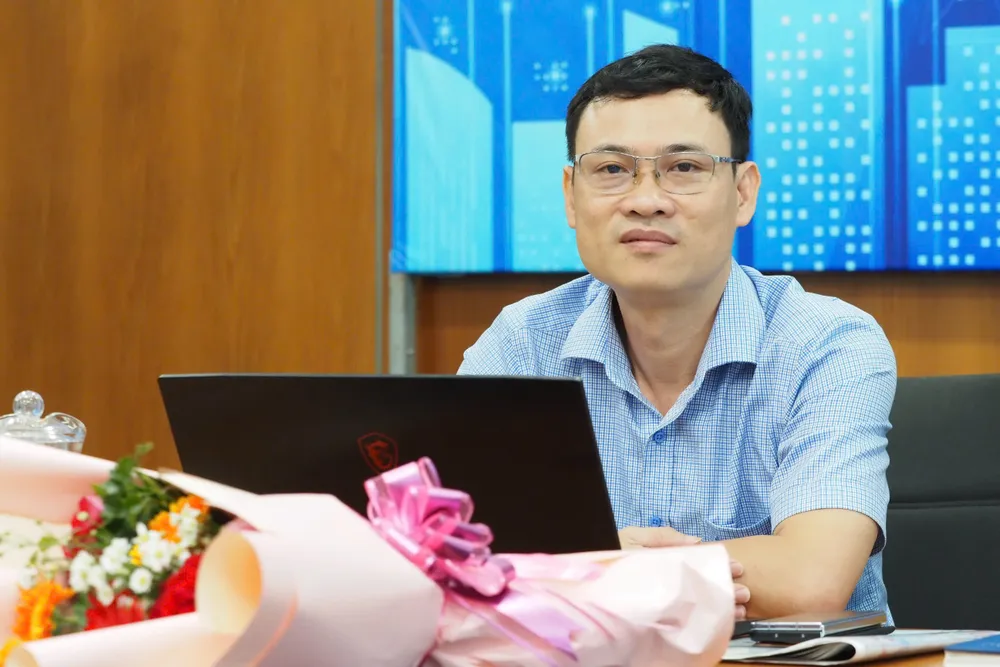
Với ứng dụng Công dân số Thành phố (App Công dân số), từ ngày chính thức công bố vận hành chính thức, Trung tâm Chuyển đổi số đã triển khai các nhóm công việc chính như:
1/ Công tác vận hành ứng dụng liên tục, an toàn;
2/ Cập nhật, cung cấp thông tin mới, kịp thời đến người dùng;
3/ Nghiên cứu và cập nhật kịp thời các tiện ích mới;
4/ Tổ chức truyền thông rộng rãi đến các cơ quan, đơn vị, địa phương và các doanh nghiệp để App Công dân số trở thành công cụ giao tiếp hiệu quả, đơn giản giữa người dân và chính quyền Thành phố.
Trung tâm Chuyển đổi số rất vinh dự khi được Ủy ban nhân dân Thành phố trao giải nhì Giải thưởng Sáng tạo thành phố năm 2024 cho giải pháp và sản phẩm App Công dân số. Trong thời gian tới, Trung tâm Chuyển đổi số sẽ tiếp tục cải tiến, cập nhật kịp thời các tiện ích trong App Công dân số phục vụ người dùng.
Cho tôi hỏi, hiện nay mạng 5G của VinaPhone đang được ứng dụng nhiều nhất trong lĩnh vực nào ạ? Những ưu điểm nổi bật là gì, và còn tồn tại khó khăn hay hạn chế nào không?

Mạng 5G Vinaphone là hạ tầng số hiện đại, có tốc độ cao và độ trễ nhỏ nên nó phục vụ gần như tất cả các ứng dụng viễn thông, chuyển đổi số của chính quyền, doanh nghiệp và người dân
Ngoài khách hàng cá nhân, hiện nay VNPT đã có các khách hàng là các doanh nghiệp kinh doanh trong lĩnh vực cung cấp truyền tải điện, nước sạch, nông nghiệp thông minh.
Tương lai, 5G sẽ là xương sống cho:
- Kỷ nguyên AI và Dữ liệu lớn : Đảm bảo khả năng kết nối và xử lý dữ liệu khổng lồ theo thời gian thực.
- Thực tế ảo/Thực tế tăng cường (VR/AR) và Metaverse: Tạo nền tảng cho các trải nghiệm số nhập vai và thế giới ảo trong tương lai.
· Tự động hóa toàn diện: Mở đường cho các thành phố thông minh, nhà máy thông minh và hệ thống giao thông tự động hóa ở quy mô lớn.
Xin lãnh đạo VNPT cho biết: Chính phủ có chính sách hỗ trợ trực tiếp các doanh nghiệp viễn thông triển khai hạ tầng 5G để phủ sóng nhanh trên toàn quốc – chính sách này thực sự mang tính đột phá. Vậy VNPT đã nhận được sự hỗ trợ này chưa, và đã triển khai như thế nào? Ông có thể cho người dân biết cụ thể được không?"

Theo Nghị định số 88/2025/NĐ-CP và Nghị quyết số 193/2025/QH15, Chính phủ hỗ trợ trực tiếp doanh nghiệp viễn thông triển khai hạ tầng 5G với điều kiện tiên quyết là. Doanh nghiệp phải lắp đặt tối thiểu 20.000 trạm phát sóng 5G trên toàn quốc (63 tỉnh/thành) trước ngày 31-12-2025, được nghiệm thu và đưa vào sử dụng từ ngày 19-2-2025.
Để thực hiện chỉ đạo của Chính phủ, VNPT đặt mục tiêu mở rộng vùng phủ sóng 5G gấp 3 lần trong năm 2025, hướng tới phục vụ 99% dân số. Tập đoàn đang tập trung vào việc nâng cấp hạ tầng viễn thông, tối ưu hóa băng tần để đảm bảo chất lượng kết nối ổn định ngay cả tại các khu vực có mật độ sử dụng cao. VNPT cũng đang hợp tác với các đối tác công nghệ để phát triển các ứng dụng khai thác tối đa tiềm năng của 5G trong kinh tế số, chính phủ điện tử và các dịch vụ đô thị thông minh.
VNPT chắc chắn sẽ đáp ứng Phát triển mới 20.000 trạm BTS phủ sóng 63 tỉnh thành (cũ), nay là 34 tỉnh thành để tận dụng được sự hỗ trợ này của chính phủ.
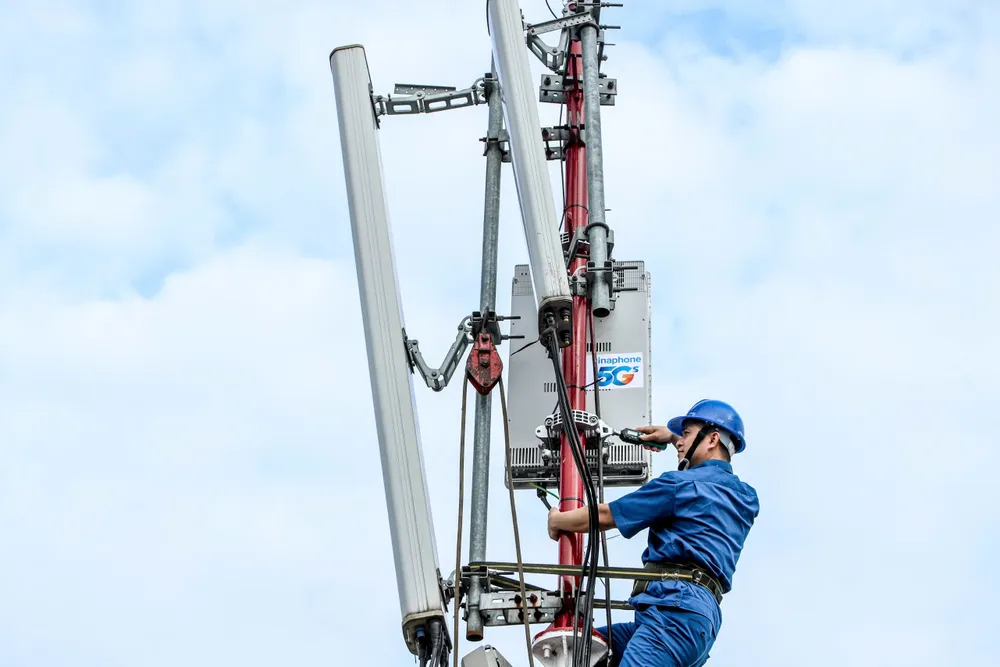
Tôi là chủ một doanh nghiệp nhỏ, phân phối thiết bị y tế, đang bước đầu chuyển đổi số, xin hỏi mạng 5G của VinaPhone có thể ứng dụng như thế nào trong việc chuyển đổi số như vận hành doanh nghiệp, kho bãi, quản lý…? Nếu có thì liên hệ như thế nào?

VNPT đang trong lộ trình triển khai một mạng 5G hoàn chỉnh và rộng khắp nhằm bảo đảm thỏa mãn tất cả các nhu cầu khác nhau của doanh nghiệp.
Vinaphone 5G sẽ có thể giúp quý doanh nghiệp trong việc quản lý chuỗi sản phẩm; điều hành phân phối sản phẩm; quản lý nhân viên nâng hiệu quả công việc; quản trị chi phí và tài nguyên tối ưu cho doanh nghiệp; quản lý khách hàng và thị trường.
Ông có thể cho biết Trung tâm đang phối hợp chiến lược với Sở Khoa học và Công nghệ như thế nào để phát triển các ứng dụng 5G hiệu quả hơn không ạ?

Sở Khoa học và Công nghệ là cơ quan thực hiện chức năng quản lý nhà nước, tham mưu cho Thành ủy, Ủy ban nhân dân Thành phố trong lĩnh vực chuyển đổi số nói chung và việc triển khai các ứng dụng 5G nói riêng. Trung tâm Chuyển đổi số là đơn vị thực thi, triển khai chuyển đổi số theo chỉ đạo, chương trình và kế hoạch của Thành phố. Nhận thức được tầm quan trọng và sứ mệnh được giao, Trung tâm Chuyển đổi số thành phố luôn chủ động, tích cực, kịp thời trong công tác phối hợp với Sở Khoa học và Công nghệ để thực hiện hiệu quả chuyển đổi số và đổi mới sáng tạo, trong đó có các ứng dụng 5G phục vụ các cơ quan, đơn vị và người dân.
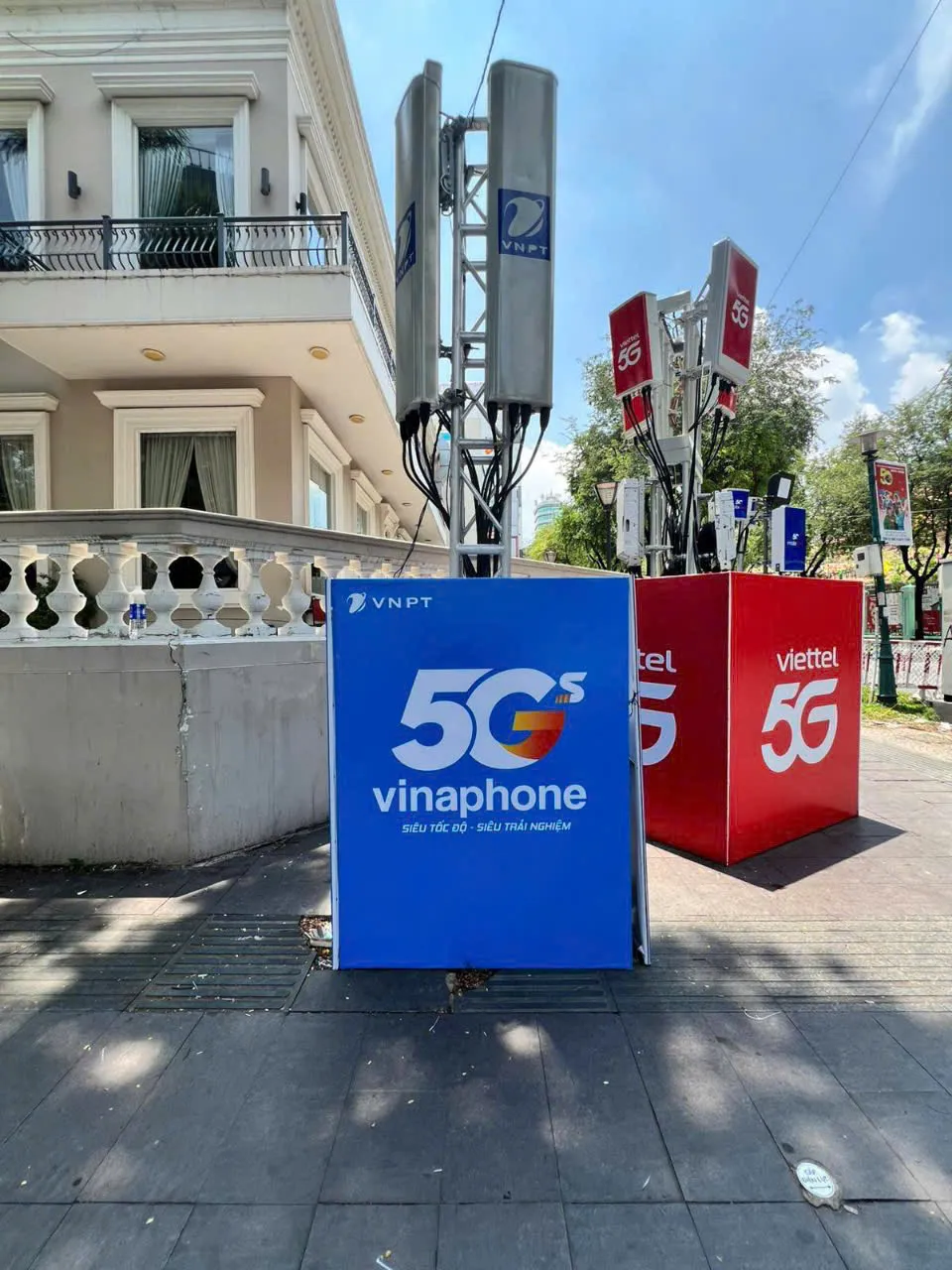
5G được kỳ vọng sẽ mở ra nhiều cơ hội mới như IoT, xe tự lái, phẫu thuật từ xa… nhưng đến nay mấy cái đó vẫn chưa phổ biến, chưa mang lại doanh thu rõ rệt. Trong khi đó, nhà mạng thì vẫn phải sống nhờ mấy dịch vụ truyền thống như gọi điện, nhắn tin, data. Vậy đây có phải là thách thức lớn nhất khi phát triển 5G hiện nay không ạ?

Theo quan điểm của tôi thì đúng như vậy.
Tuy nhiên, sự thay đổi sẽ rất nhanh chóng. Thực tế, doanh thu từ dịch vụ, giải pháp CNTT trên nền 5G tăng rất nhanh trong những tháng gần đây. Bản thân khách hàng (chính quyền, doanh nghiệp, người dân) tự thay đổi rất nhiều
Các dịch vụ như: DV công trực tuyến (Chính phủ); VNEdu cho giáo dục; HIS cho Y tế; IoC cho tỉnh thành phố; các dịch vụ IoT quản lý tủ điện cho điện lực; quản lý đồng hồ nước cho cấp nước; quản lý đoàn xe cho DN Logistics đóng góp gia tăng doanh số cho Vinaphone 5G.
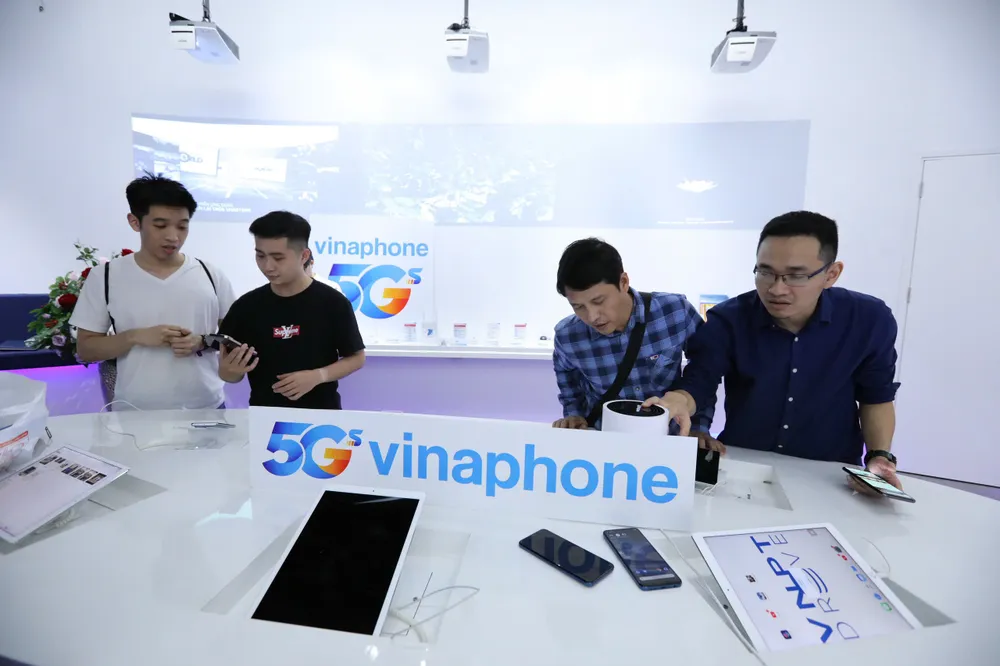
Tôi đang làm làm trong lĩnh vực tư vấn chuyển đổi số cho doanh nghiệp, xin hỏi hạ tầng mạng 5G của đơn vị có đảm bảo hoạt động thông suốt cho doanh nghiệp không? Tốc độ gửi nhận tín hiệu ra sao? Việc bảo mật thông tin cho khách hàng như thế nào?

VNPT đang trong lộ trình triển khai một mạng 5G hoàn chỉnh, rộng khắp và thông suốt nhằm bảo đảm thỏa mãn tất cả các nhu cầu khác nhau của doanh nghiệp. Trong quá trình đó việc bảo đảm an toàn thông tin, bảo mật thông tin cho khách hàng luôn được VNPT đặt ưu tiên hàng đầu. Bảo mật của VNPT được quan tâm ở mọi lớp mạng; ở mọi dịch vụ; ở mọi giao thức và quy trình và hỗ trợ khách hàng (Chính quyền, doanh nghiệp và người dân) bằng sản phẩm, giải pháp riêng và theo yêu cầu của khách hàng.
Với VNPT, Trung tâm đã có những hoạt động hợp tác nào để cùng phát triển hạ tầng số nói chung và mạng 5G nói riêng không ạ? Những hợp tác này đang triển khai đến đâu rồi, thưa ông?

Đối với các nhà cung cấp dịch vụ hạ tầng viễn thông như VNPT, Viettel, FPT Telecom, GTel, Trung tâm Chuyển đối số TPHCM đã phối hợp, có những hoạt động hợp tác trong thời gian qua tại TPHCM để thiết lập, triển khai hạ tầng truyền dẫn, hạ tầng số phục vụ vận hành các ứng dụng số trong công tác quản lý nhà nước và dịch vụ công trực tuyến, ứng dụng tiện ích của người dân.
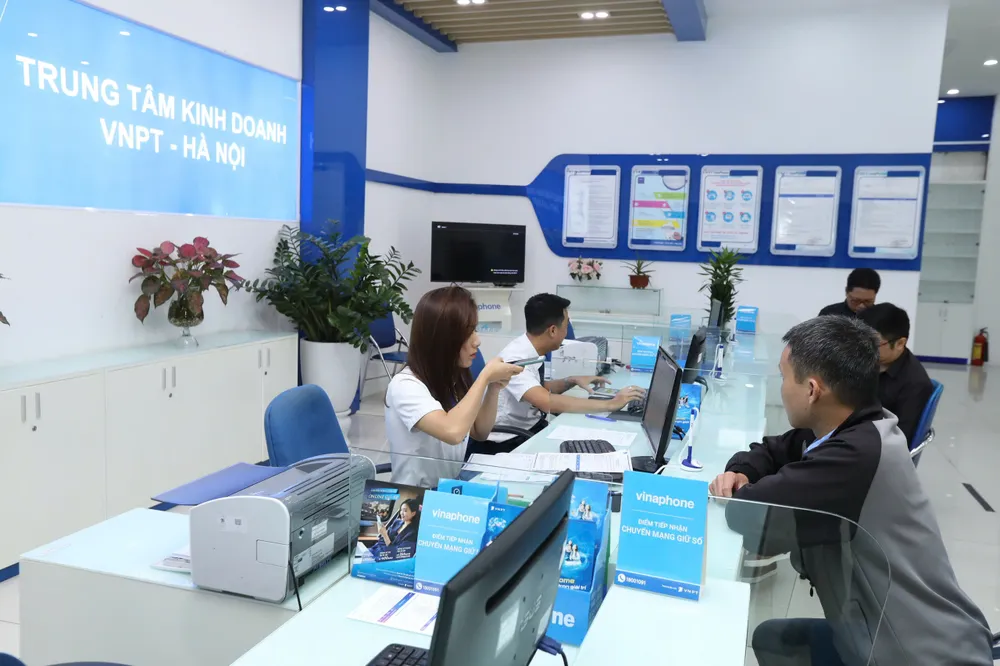
Hiện nay, nhiều khách hàng chưa mặn mà với 5G vì giá cước còn cao, mà dùng mấy tác vụ cơ bản như xem video, lướt web thì thấy dung lượng data tụt rất nhanh. Vậy phía nhà mạng có chia sẻ gì về vấn đề này không, và có hướng điều chỉnh hay giải pháp nào để người dùng dễ tiếp cận hơn không ạ?

Để giải quyết vấn đề nêu trên, Vinaphone hiện nay có rất nhiều gói cước đa dạng với giá cả phải chăng, phù hợp với nhu cầu sử dụng Data của khách hàng. Cũng cần nhấn mạnh là Vinaphone hiện nay không phân biệt gói cước dịch vụ 5G và 4G, do đó khách hàng hiện hữu hoàn toàn có thể trải nghiệm dịch vụ 5G với mức cước của dịch vụ 4G.
Tôi nghe nói VinaPhone đã có 5G, vậy dùng thực tế có nhanh rõ rệt so với 4G không ? Có gì khác biệt mà người dùng nên thử không ạ?

Vinaphone (VNP) đã thương mại hóa 5G từ năm 2024. HIện có hơn 3 triệu thuê bao 5G. Thực tế chất lượng dịch vụ VNP 5G nhanh hơn rất nhiều so với 4G và độ trễ thấp hơn. Lý tưởng tốc độ download có thể đạt trên 1Gbps, độ trễ nhỏ hơn 10ms. Trung bình hiện nay theo Ookla công bố thì VNP 5G đạt 354.44 Mbps; upload đạt 94.92 Mbps.
Tất nhiên với công nghệ mới và chất lượng tốt hơn thì người dùng nên/phải thử và dùng thật để tăng trải nghiệm.
Nguồn: https://www.sggp.org.vn/5g-don-bay-cho-doi-song-so-o-thanh-pho-hon-14-trieu-dan-post802008.html



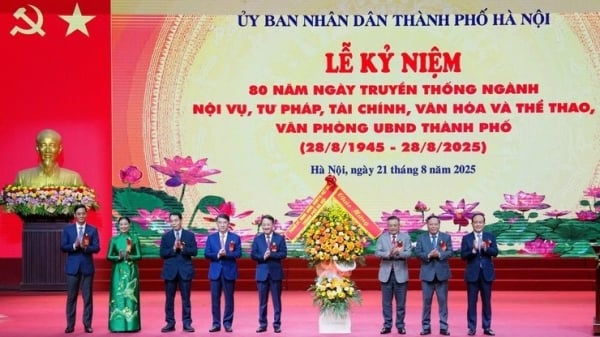






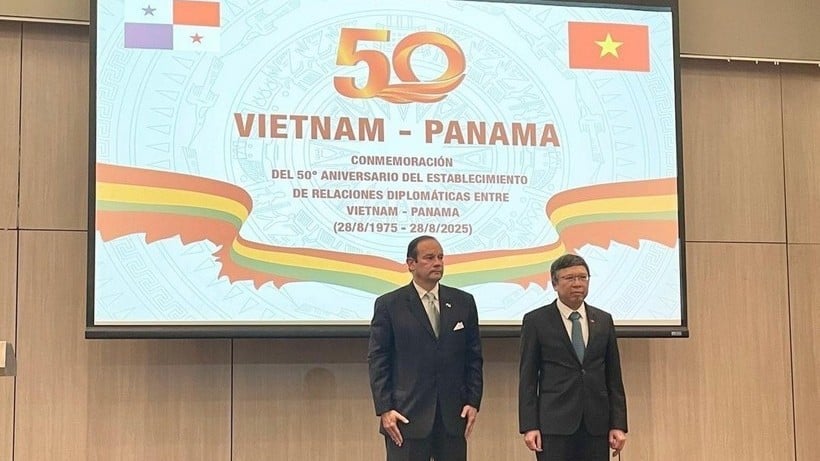













![[Photo] New look of the coastal city on the Han River](https://vstatic.vietnam.vn/vietnam/resource/IMAGE/2025/8/22/26f58a4a29b9407aa5722647f119b498)
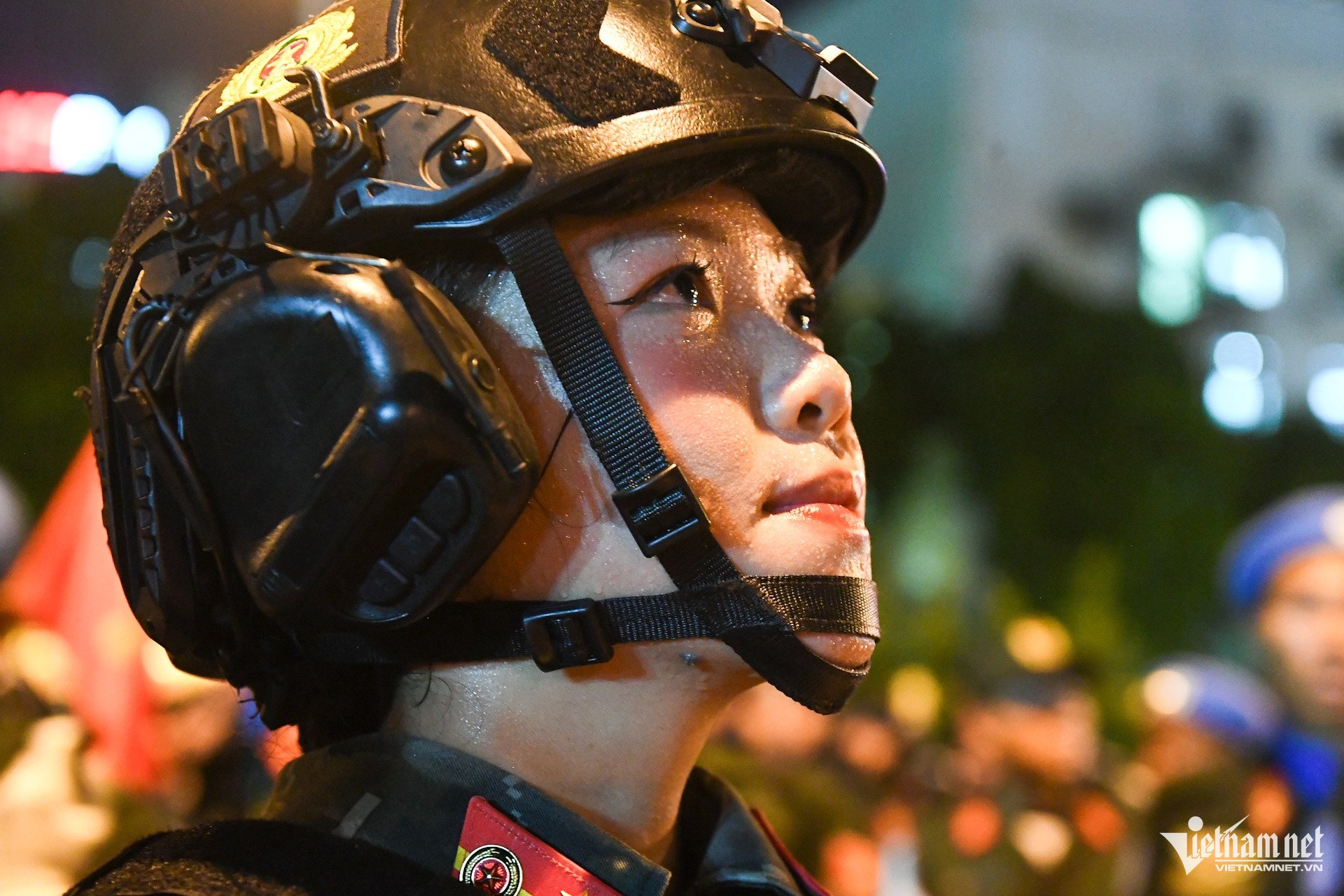







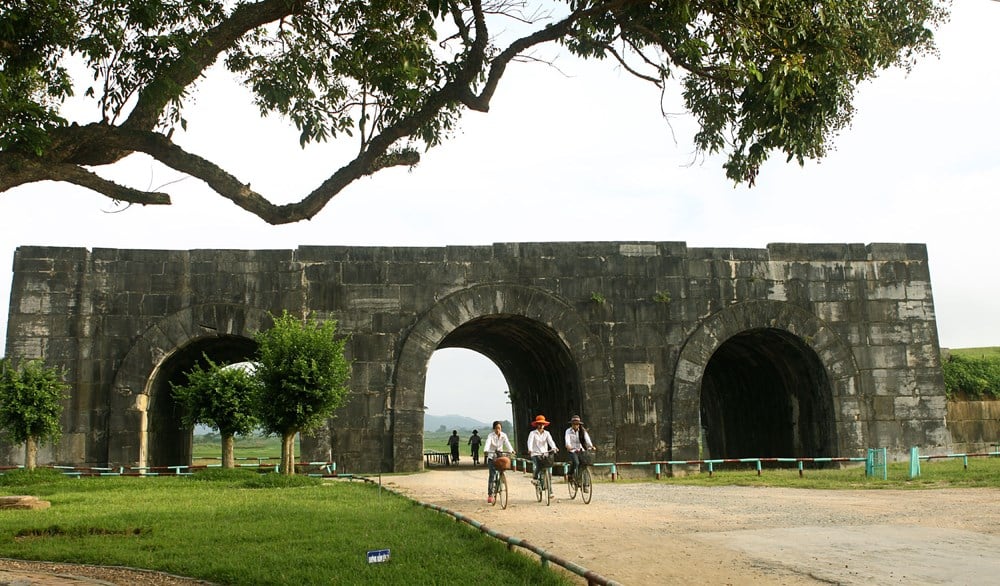







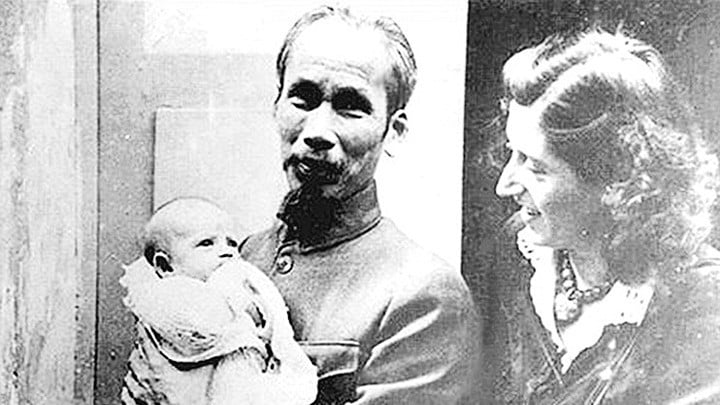










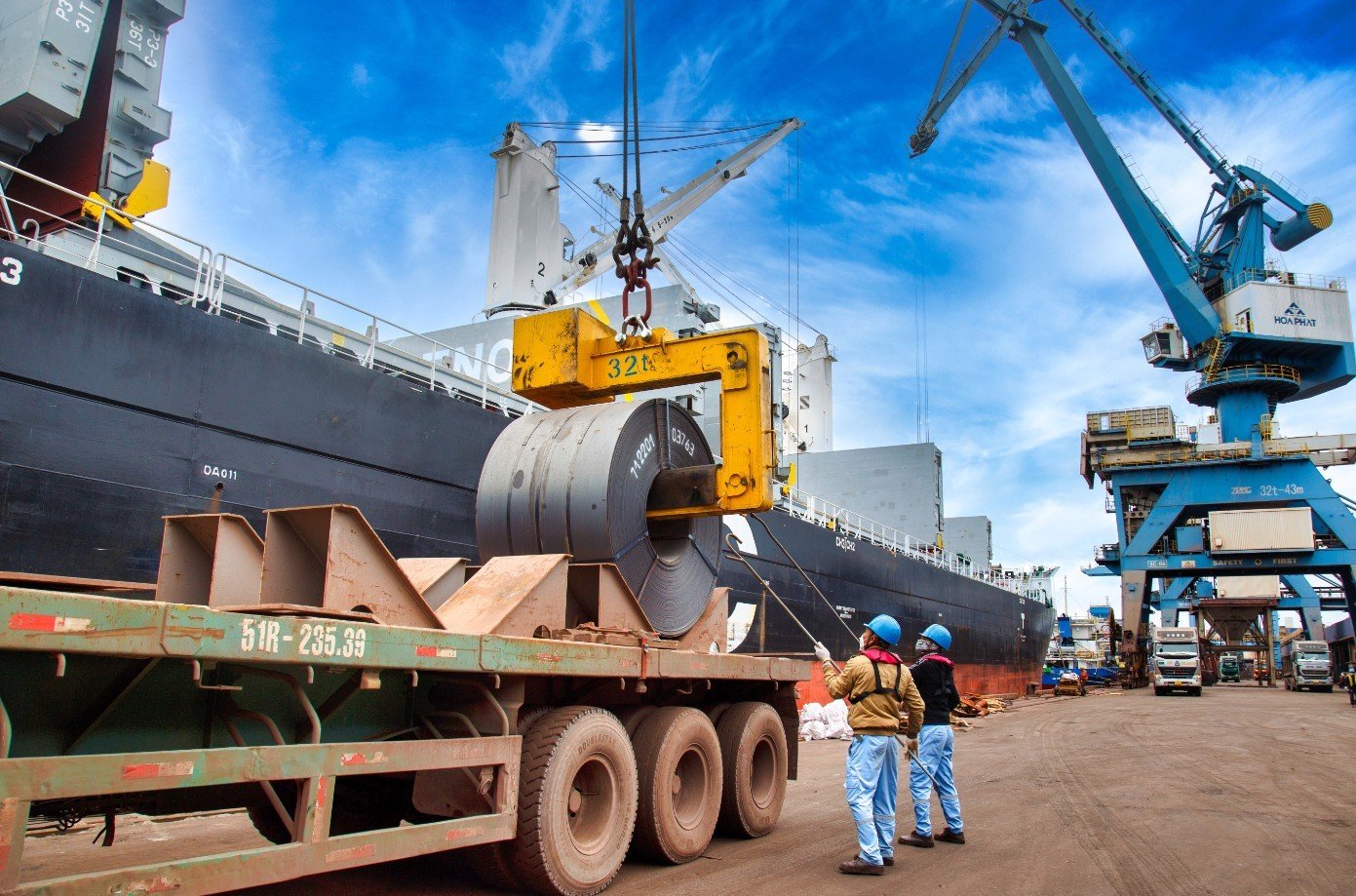












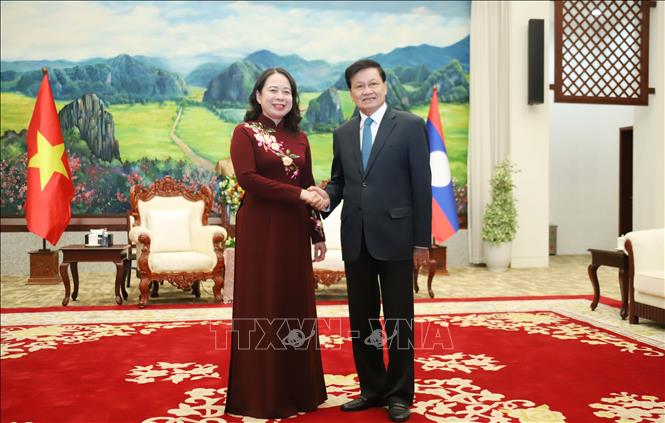































Comment (0)